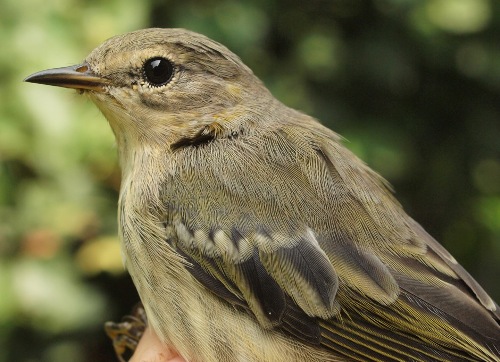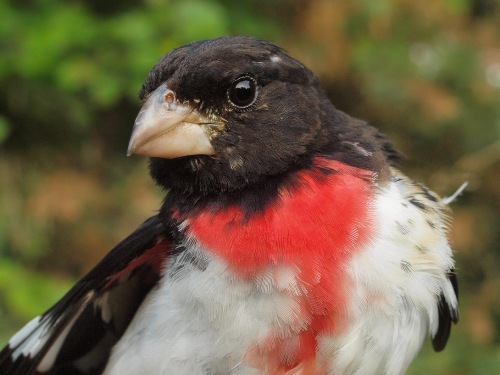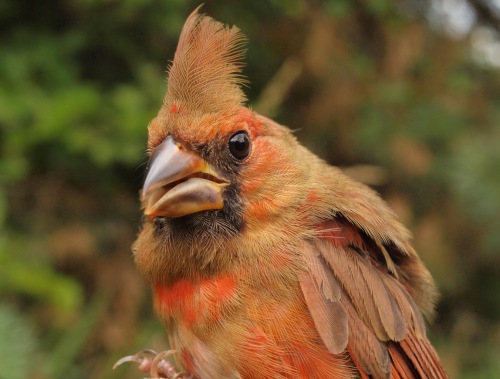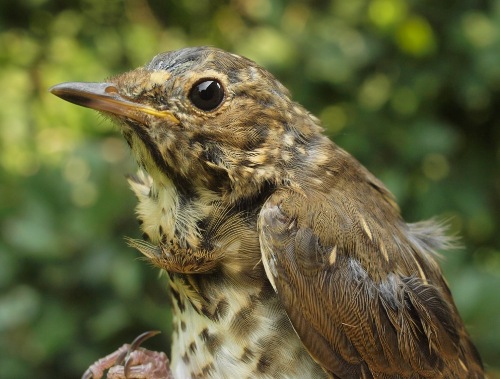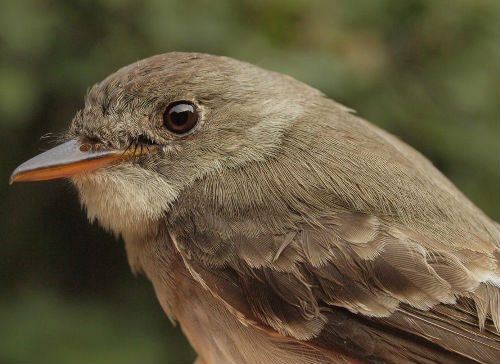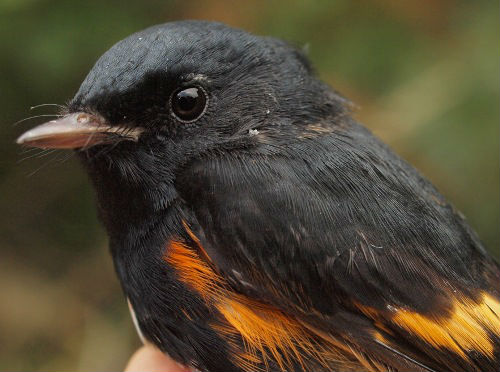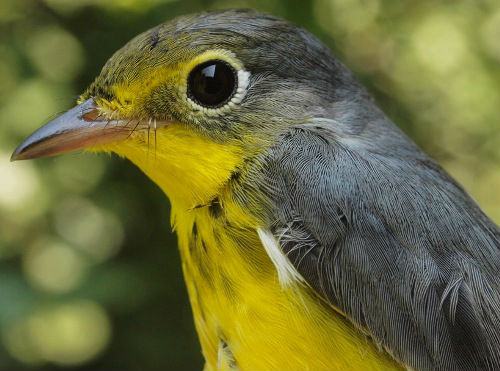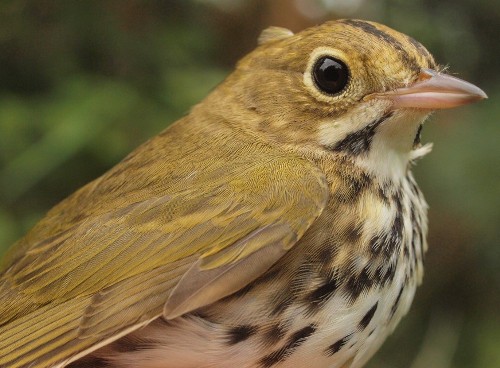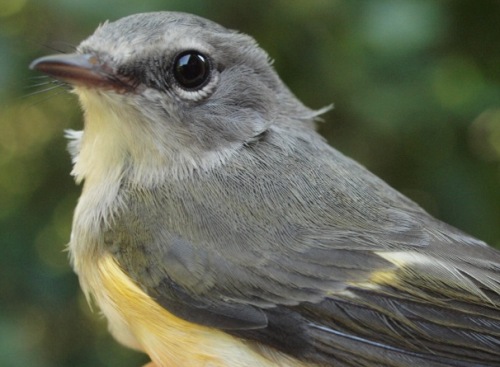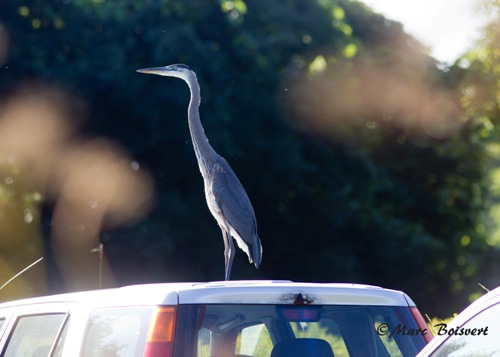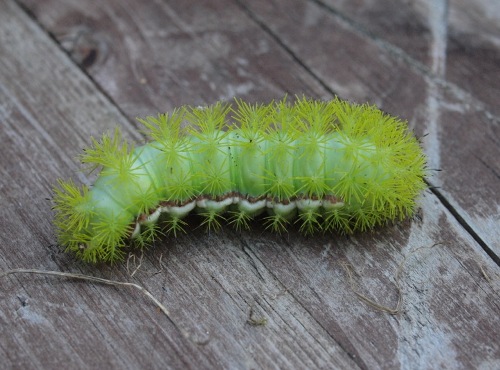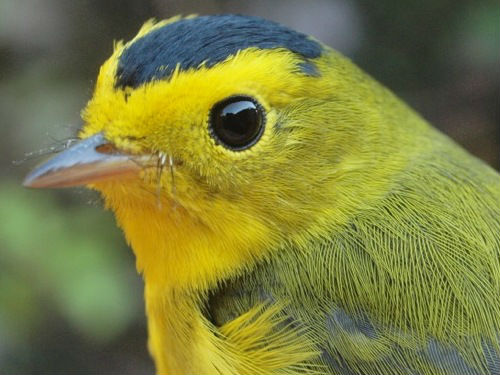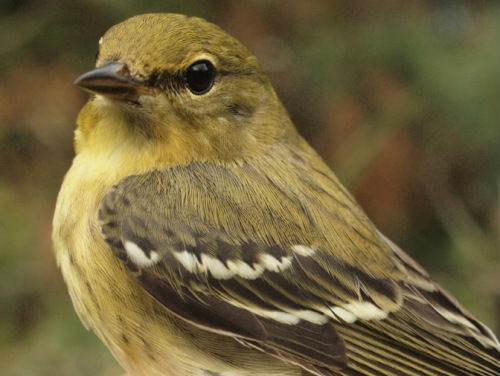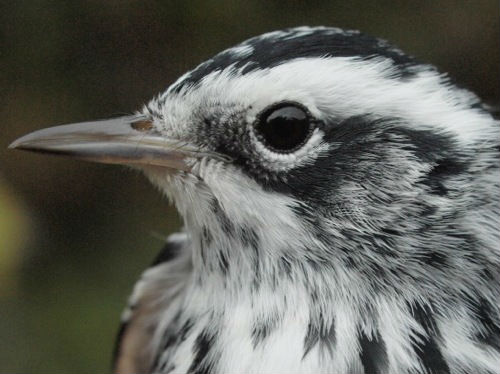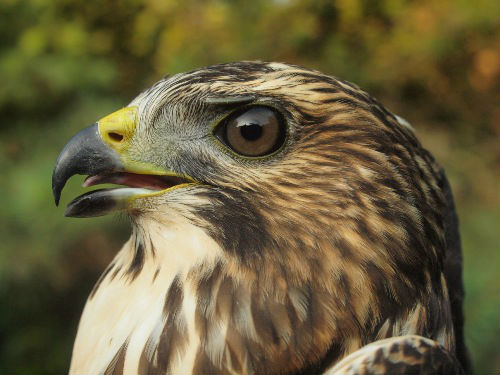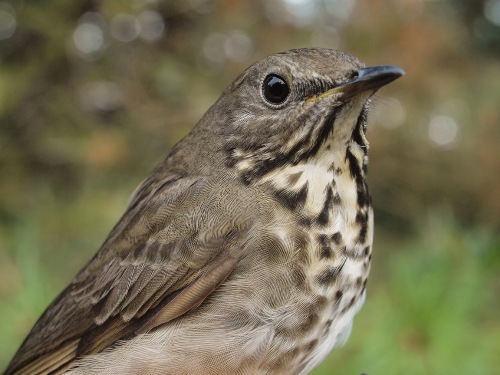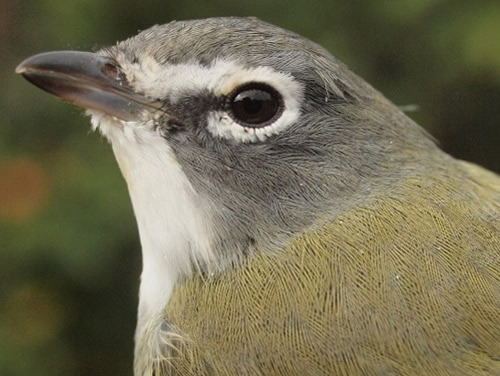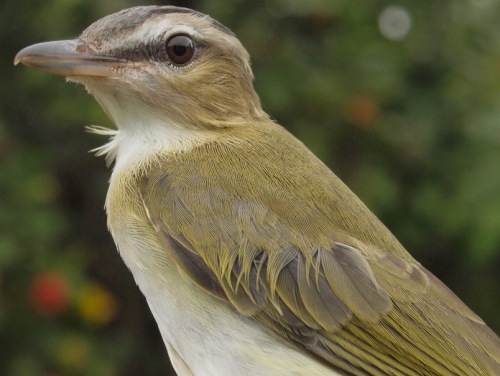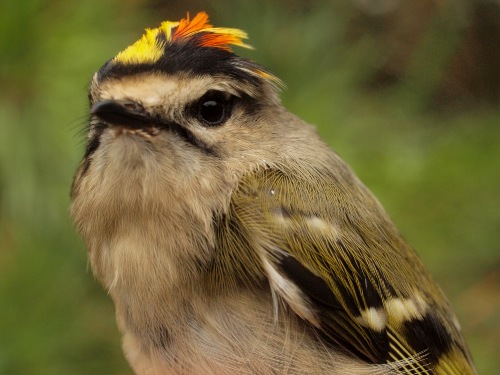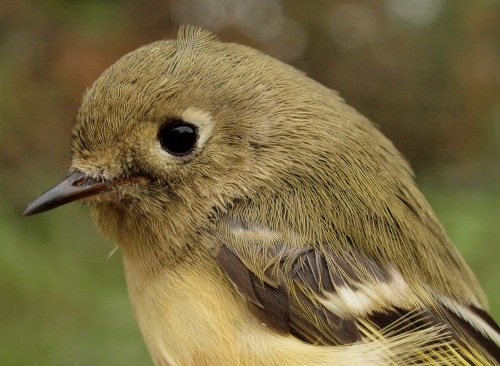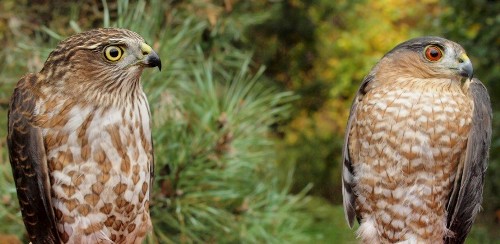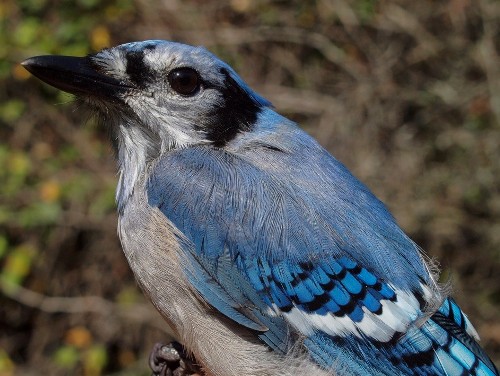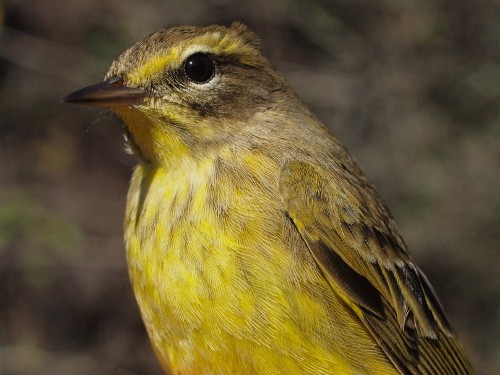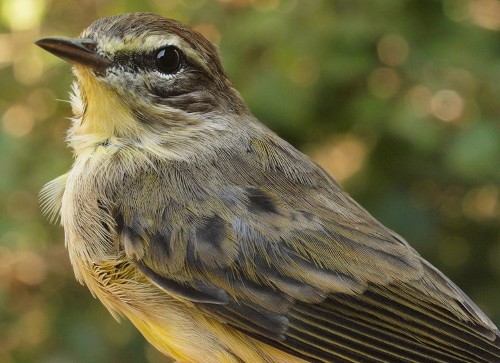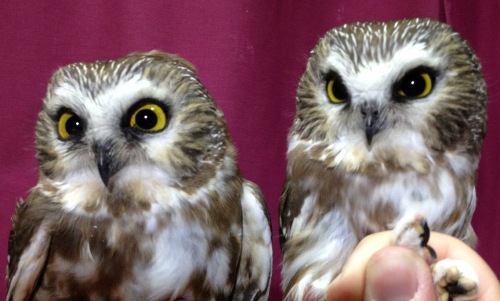Week 1: August 1-7, 2014
[
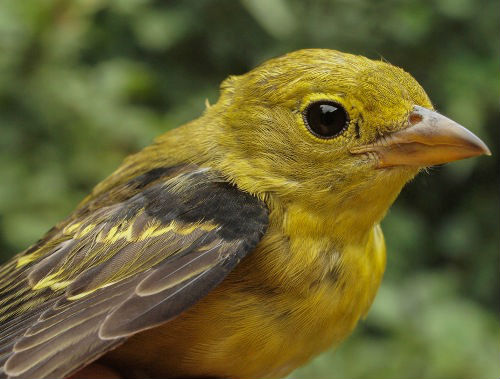 Although we have banded Scarlet Tanager annually over MBO’s ten-year history, there are five years when only a single individual was banded. This was the first for 2014. ] |
| THIS WEEK | THIS FALL | 2006 TOTAL | SITE TOTAL | |
|---|---|---|---|---|
| # birds (and species) banded | 202 (42) | 202 (42) | 1701 (45) | 48011 (113) |
| # birds (and species) repeat | 43 (19) | 43 (19) | 382 (41) | 9516 (70) |
| # birds (and species) return | 13 (9) | 13 (9) | 153 (28) | 1587 (38) |
| # species observed | 78 | 78 | 145 | 209 |
| # net hours | 548.0 | 548.0 | 3961.4 | 83144.7 |
| # birds banded / 100 net hours | 36.9 | 36.9 | 42.9 | 57.7 |
Note: table does not include nocturnal banding (owls)
Bander-in-charge:Simon Duval .
Assistants:Angelika Aleksieva, Christine Barrie, Nicolas Bernier, Cindy Bouchard, Marie-France Boudreault, David Davey, Geneviève Dubois, Barbara Frei, Marcel Gahbauer, Nathalie Gendron, Alison Hackney, Lisa Keelty, Marcel Lebeau, Ana Morales, Benoît Piquette, Catherine Russell, Carollynne Smith, Rodger Titman, Christiane Tremblay.
Notes: Just 8 weeks ago we concluded our record-breaking tenth Spring Migration Monitoring Program – and already the fall equivalent is underway again! Such is the nature of migration in southern Quebec, where in fact some species (primarily shorebirds) have already been heading back south for several weeks. However, our traditional start date of August 1 is early enough for us to be monitoring the first of the songbird migrants, among them Tennessee and Yellow Warblers..
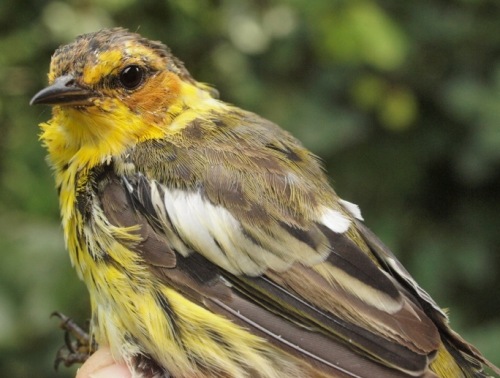
Some parts of Quebec (especially the Saguenay region) had remarkable numbers of breeing Cape May Warblers this summer, a reflection of the province’s spruce budworm outbreak. The adult (very likely second-year) male above marks the first time we have had this species at MBO as a molt migrant. More often, the Cape May Warblers banded at MBO are hatch-year birds, like the one below also banded this week.
(Photos by Simon Duval)
Since 2009, the number of birds banded in the first week of fall has increased every year, from 228 that year to 300 in 2013. However, that pattern came to an end this year, with a modest total of only 202 for the week. Perhaps not coincidentally, we also had our lowest first-week count of Song Sparrows since 2009. It isn’t that birds were not on the move though – the 78 species observed over the course of the week was well above average, and only behind the 84 recorded at this time last year. Among these were our first Pied-billed Grebe and Black-crowned Night Heron sightings of 2014. Meanwhile the 42 species banded is a record high for week 1 of the fall season, and included four species new for the year – Yellow-shafted Flicker, Scarlet Tanager, Indigo Bunting, and House Finch.
| # individuals banded | mean # individuals observed daily |
|---|---|
| 1. American Redstart (29) [5] | 1. American Robin (27) [3] |
| 2. Song Sparrow (26) [1] | 2. Black-capped Chickadee (20) [6] |
| 3. Gray Catbird (18) [4] | 3. American Goldfinch (16) [5] |
| 4. Red-eyed Vireo (16) [6] | 4. Song Sparrow (16) [2] |
| 5. Black-capped Chickadee (11) [7] | 5. Common Grackle (13) [8] |
| 6. American Robin (8) [10] | 6. Blue Jay (12) [7] |
| 7. Northern Waterthrush (7) [5] | 7. Cedar Waxwing (11) [1] |
| 7. Tennessee Warbler (7) [-] | 8. American Crow (11) [4] |
| 7. Yellow Warbler (7) [3] | 9. Red-winged Blackbird (9) [10] |
| 7. Rose-breasted Grosbeak (7) [7] | 10. American Redstart (8) [-] |
The number of American Redstarts banded at MBO in fall increased for five years in a row from 2007-2011, and has since stabilized at under just 150 annually. They have also been arriving ever earlier … over the course of our first five years, they only twice appeared in the top ten in week 1, peaking in early September. However, over the past four years they have routinely been in the top five – and this year took top spot for the first time, narrowly edging out Song Sparrow, which has been dominant in six of nine previous years. The other three years, the top ranking was occupied by Yellow Warbler, which was rather scarce this week, in a four-way tie for seventh place with Northern Waterthrush, Tennessee Warbler, and Rose-breasted Grosbeak. While we often band a decent number of Gray Catbirds at the start of fall, the 18 this week substantially eclipsed the previous record of 13 set last year. Similarly, our previous high for Red-eyed Vireos in week 1 was 13 (in 2012), and we raised the bar this week. Rounding out the middle of the top ten were Black-capped Chickadee and American Robin, both representing the typical catch of local juveniles.
The dominant species observed in week 1 have varied considerably over the years, with top spot variably occupied by American Crow (2012), Cedar Waxwing (2010, 2013), Song Sparrow (2005), Red-winged Blackbird (2006, 2007, 2011), Common Grackle (2009), and American Goldfinch (2008) … now joined by American Robin for 2014. All of the other regulars were in this year’s top ten as well, although Black-capped Chickadees dominated enough to sneak in as the runner-up ahead of them. The other interlopers in the list were Blue Jay (an unusually high count for this early in fall), and American Redstart, reflecting the surge in numbers banded.
Our tenth fall season has just begun! We look forward to the next 12 weeks and sharing our results as the season progresses. Be sure to also check out our Facebook page for live updates and additional photo highlights throughout the season.
Week 2: August 8-14, 2014
[
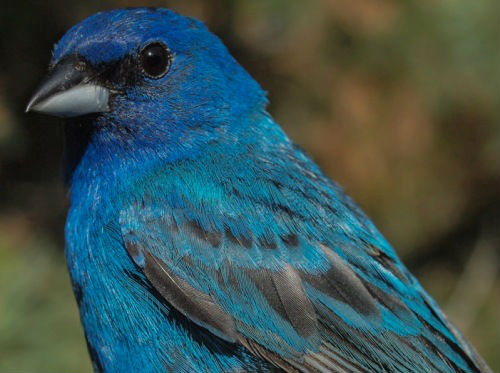 Soon Indigo Buntings will be molting – but for now we still have at least one ] |
| THIS WEEK | THIS FALL | 2006 TOTAL | SITE TOTAL | |
|---|---|---|---|---|
| # birds (and species) banded | 191 (39) | 393 (48) | 1892 (77) | 48202 (113) |
| # birds (and species) repeat | 48 (19) | 91 (28) | 430 (45) | 9564 (70) |
| # birds (and species) return | 3 (2) | 16 99) | 156 (28) | 1590 (38) |
| # species observed | 81 | 91 | 145 | 209 |
| # net hours | 472.0 | 1020.0 | 4433.4 | 83616.7 |
| # birds banded / 100 net hours | 40.5 | 38.5 | 42.7 | 57.6 |
Note: table does not include nocturnal banding (owls)
Bander-in-charge:Simon Duval and Gay Gruner .
Assistants:Angelika Aleksieva, Marie-France Boudreault, Jo-Annie Gagnon, Marcel Gahbauer, Alison Hackney, Lisa Keelty, Helen Kohler, Lance Laviolette, Marcel Lebeau, Barbara MacDuff, Ana Morales, Benoît Piquette, Elise Titman, Rodger Titman, Christiane Tremblay, Jay VanderGaast.
Notes: Since 2009, the number of birds banded in week 2 has always dropped from the previous week. With a below average start to the 2014 fall season, we were hoping that trend might be broken, but it was not to be (although at least the difference was a modest one, just a dozen fewer birds this week. Again though the number of species observed (81) was above average for this point in the season..

Some local birds were banded at MBO this week, including the juvenile Cedar Waxwing above, and adult Eastern Phoebe below.
(Photos by Simon Duval)
This week we observed only one new species for the year – Greater Yellowlegs. We kicked off the week banding two new species for 2014 on August 8 – Eastern Wood-Pewee and Philadelphia Vireo.
| # individuals banded | mean # individuals observed daily |
|---|---|
| 1. American Redstart (38) [1] | 1. American Robin (22) [1] |
| 2. Song Sparrow (20) [2] | 2. Cedar Waxwing (16) [7] |
| 3. Gray Catbird (15) [3] | 3. Common Grackle (16) [5] |
| 4. American Robin (8) [6] | 4. American Goldfinch (16) [3] |
| 5. Red-eyed Vireo (6) [4] | 5. Black-capped Chickadee (14) [2] |
| 5. Black-capped Chickadee (6) [5] | 6. Blue Jay (11) [6] |
| 5. Cedar Waxwing (6) [-] | 7. American Redstart (10) [10] |
| 5. Tennessee Warbler (6) [7] | 7. Song Sparrow (10) [4] |
| 5. Common Yellowthroat (6) [-] | 9. Red-eyed Vireo (8) [-] |
| 5. Rose-breasted Grosbeak (6) [7] 5. White-throated Sparrow (6) [-] |
9. Red-eyed Vireo (8) [-] |
The top three species banded this week were the same as in week 1 – American Redstart, Song Sparrow, and Gray Catbird. While numbers dropped slightly for the latter two, the count of redstarts actually increased. This marks the fourth time in our ten-year fall program that American Redstart has been the top species in week two (also in 2008, 2011, and 2012), and the 38 individuals banded this week was just short of the record of 39 in 2012. The next three species in the list (American Robin, Red-eyed Vireo, and Black-capped Chickadee) are also the same as last week, just shuffled around a bit. In reality though, the vireo and chickadee were part of an unprecedented seven-way tie for fifth place that also involved Cedar Waxwing, Tennessee Warbler, Common Yellowthroat, Rose-breasted Grosbeak, and White-throated Sparrow – all of which are relatively regular at this time of year.
Among species observed, American Robins dominated for a second week in a row. This is a bit of surprise, as the species has consistently ranked between fifth and ninth place in previous years, and a maximum mean daily count of 18. It’s usually late in fall that American Robins are outnumbering other species … is this an early sign of what is to come in October? Among other species, there was a fair bit of shuffling of positions, but the only new addition to the top ten this week was Red-eyed Vireo.
Week 3: August 15-21, 2014
|
Note: table does not include nocturnal banding (owls)
Bander-in-charge:Simon Duval and Gay Gruner .
Assistants:Angelika Aleksieva, Johannie Bernard, Nicolas Bernier, Sue Bishop, Marc Boisvert, Cindy Bouchard, Marie-France Boudreault, David Davey, Jean Demers, Geneviève Dubois, Lauriane Dubuc, Barbara Frei, Alison Hackney, Lisa Keelty, Helen Kohler, Lance Laviolette, Agathe Lebeau, Marcel Lebeau, Barbara MacDuff, Raymon Michaud, Ana Morales, Raymonde Palardy, Benoît Piquette, Catherine Russell, Ahmad Shah, Carollynne Smith, Clémence Soulard, Rodger Titman, Christiane Tremblay.
Notes: We have come to know that week 3 is typically the quietest of our 13 weeks of fall migration. Even so, it was particularly slow this week, with the 132 birds banded the second-fewest ever for this period. Once again though, observers were rewarded with a rich variety of birds – the 88 species observed is the second-highest total ever for week 3 (only behind last year’s incredible count of 95), and similarly the cumulative total of 105 for the season is ahead of the pace for all previous years except for 2013..
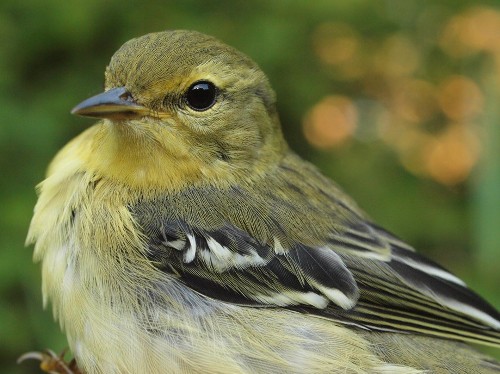
Blackpoll Warbler usually peaks at MBO in September, but some individuals are already moving through.
(Photo by Simon Duval)
The only new species observed for the year this week was Common Nighthawk; among the birds banded, none were new for 2014, but we did have our first Blackpoll Warbler of the fall .
| # individuals banded | mean # individuals observed daily |
|---|---|
| 1. American Redstart (13) [1] | 1. Common Grackle (36) [3] |
| 2. Tennessee Warbler (9) [5] | 2. American Robin (28) [1] |
| 2. Magnolia Warbler (9) [-] | 3. American Goldfinch (19) [4] |
| 4. Ovenbird (8) [-] | 4. Tree Swallow (17) [-] |
| 4. Song Sparrow (8) [2] | 5. American Crow (17) [-] |
| 6. American Robin (7) [4] | 6. Cedar Waxwing (15) [2] |
| 6. Gray Catbird (7) [3] | 7. Red-winged Blackbird (14) [10] |
| 8. Red-eyed Vireo (6) [5] | 8. Black-capped Chickadee (13) [5] |
| 8. Northern Waterthrush (6) [-] | 9. Blue Jay (11) [6] |
| 8. Common Yellowthroat (6) [5] | 10. Broad-winged Hawk (11) [-] |
Despite the overall drop in number of birds banded this week, American Redstart managed to hold on to first place for the third straight week – a spot it has occupied for week 3 in five of the last seven years. It was certainly a week of warblers, with five other species in the top ten as well, including two holdovers from last week (Tennessee Warbler and Common Yellowthroat), and three new additions (Ovenbird, Northern Waterthrush, and Magnolia Warbler). Again American Robin hovered around the middle of the pack, although Black-capped Chickadees have dropped out of the top ten (we are still catching this year’s juveniles – it’s just that by now they are being classified as repeats, rather than new birds banded.
The mean daily count of American Robins has remained steady in the twenties, but this week Common Grackle was a bit more numerous. While Common Grackle has typically not been very numerous at this point in fall, it did dominate week 3 once previously in 2012 (and by a much more significant margin, with a mean daily count of 186 in that case!). Most notable among this week’s three newcomers in the top ten was Tree Swallow, which has only shown up on the list for week 3 once previously, with a mean daily count of 11 individuals in 2007. Given that swallow numbers have been in steady decline for the past several years, this was a pleasant surprise. Perhaps even more surprising though was the large movement of Broad-winged Hawks, given that their migration usually peaks sharply around a mid-September peak – and over our first five years of fall migration monitoring, we counted only a grand total of six individuals during week 3!
Week 4: August 22-28, 2014
[
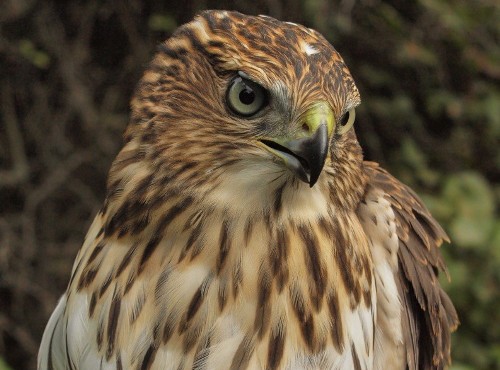 The star of the week was this hatch-year Cooper’s Hawk, only the fourth one ] |
| THIS WEEK | THIS FALL | 2006 TOTAL | SITE TOTAL | |
|---|---|---|---|---|
| # birds (and species) banded | 296 (38) | 809 (54) | 2308 (78) | 48618 (113) |
| # birds (and species) repeat | 61 (17) | 196 (34) | 535 (48) | 9669 (70) |
| # birds (and species) return | 8 (6) | 30 (14) | 170 (30) | 1604 (38) |
| # species observed | 87 | 110 | 147 | 209 |
| # net hours | 537.0 | 2001.0 | 5414.4 | 84597.7 |
| # birds banded / 100 net hours | 55.1 | 40.4 | 42.6 | 57.5 |
Note: table does not include nocturnal banding (owls)
Bander-in-charge:Simon Duval and Gay Gruner .
Assistants:Angelika Aleksieva, Johannie Bernard, Sue Bishop, Marc Boisvert, Cindy Bouchard, Marie-France Boudreault, Manon Bourdon, Luke Currin, David Davey, Geneviève Dubois, Jo-Annie Gagnon, Alison Hackney, Frédéric Hareau, Lisa Keelty, Agathe Lebeau, Marcel Lebeau, Barbara MacDuff, Francine Marcoux, Betsy McFarlane, Ana Morales, Ted Murphy-Kelly, Ahmad Shah, Patricia Stotland, Elise Titman, Rodger Titman, Christiane Tremblay, Michel Vorasane.
Notes: We breathed a sigh of relief as migration finally showed signs of kicking into high gear. The 296 birds banded this week more than doubled last week’s total, and was also the second-highest ever count for this point in the season (behind only the 330 during this week last year). The diversity of species observed also remained well above average, with 87 species over the course of the week, just one less than last year’s record high. Also consistent with the trend, the number of returns so far this fall (30 to date) is just short of record pace..
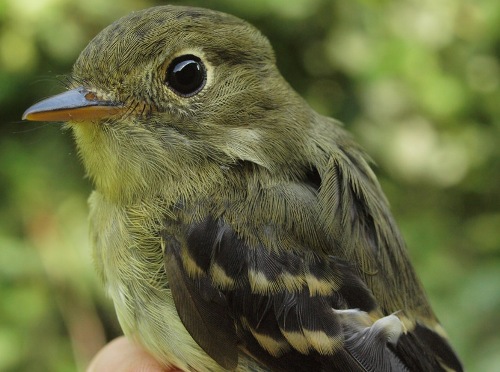
Yellow-bellied Flycatchers were banded at MBO this week in unprecedented numbers.
(Photo by Simon Duval)
We only banded one new species for the year this week, but it was a notable one – Cooper’s Hawk. This was only our fourth individual banded in MBO’s history, although we have now had one in each of the past three fall seasons. Another four species were banded for the first time this fall – Hermit Thrush, Northern Parula, Black-throated Green Warbler, and Wilson’s Warbler.
| # individuals banded | mean # individuals observed daily |
|---|---|
| 1. Tennessee Warbler (56) [2] | 1. American Robin (30) [2] |
| 2. Magnolia Warbler (40) [2] | 2. American Goldfinch (25) [3] |
| 3. Northern Waterthrush (18) [8] | 3. American Crow (22) [4] |
| 4. Common Yellowthroat (16) [8] | 4. Cedar Waxwing (21) [6] |
| 5. Yellow-bellied Flycatcher (15) [-] | 5. Black-capped Chickadee (19) [8] |
| 5. American Redstart (15) [1] | 6. Common Grackle (14) [1] |
| 7. Nashville Warbler (13) [-] | 7. Tennessee Warbler (14) [-] |
| 7. Song Sparrow (13) [4] | 8. Blue Jay (12) [9] |
| 9. Red-eyed Vireo (11) [8] | 9. Red-eyed Vireo (9) [-] |
| 10. Least Flycatcher (10) [-] | 10. Magnolia Warbler (9) [-] |
The wave of migration that swept through MBO this week shook up the composition of dominant species a fair bit. Whereas American Redstart had dominated the banding totals over the first three weeks of the season, it tumbled into a tie for fifth place, with two of the “mid-fall” warblers (Tennessee and Magnolia) arriving in big numbers, while Northern Waterthrush and Common Yellowthroat also increased to land in the top four. This is typically the point in fall when Magnolia Warblers take over, having been the top species banded for week 4 in seven of nine previous years. However, like last year, Tennessee Warbler came out ahead again this year. Without question though, the week’s biggest surprise was Yellow-bellied Flycatcher – easily a single-week record for the species, and more than we’ve banded in several entire seasons. The same applies for Least Flycatcher, despite a somewhat smaller total, and especially noteworthy as over the past three years our fall season total for the species has ranged from 3 to 8. Rounding out this week’s top ten, we continued to band modest numbers of Song Sparrows and Red-eyed Vireos, and Nashville Warblers also began to make their presence known.
After last week being displaced from the top spot for the first time this fall, American Robin again was the most common species observed this week, part of an “all-American” top three that also included American Goldfinch and American Crow. Common Grackle fell back toward the middle of the top ten, while Black-capped Chickadee increased a bit compared to last week. Reflecting the large numbers we banded, Tennessee and Magnolia Warblers showed up in the bottom part of the top ten of species observed, as did Red-eyed Vireo this week. Blue Jay numbers have remained steady so far throughout August.
Week 5: August 29 – September 4, 2014
Note: table does not include nocturnal banding (owls)
Bander-in-charge:Simon Duval and Gay Gruner .
Assistants: Veronica Aponte, Sue Bishop, Cindy Bouchard, Marie-France Boudreault, Manon Bourdon, Luke Currin, Jean Demers, Nathalie Gendron, Alison Hackney, Frédéric Hareau, Lisa Keelty, Helen Kohler, Agathe Lebeau, Marcel Lebeau, Betsy McFarlane, Ana Morales, Catherine Russell, Ahmad Shah, Clémence Soulard, Patricia Stotland, Sophie Tessier, Elise Titman, Rodger Titman, Christiane Tremblay
Notes: It was a great week of weather at MBO, with the nets fully open for all standard hours. However, numbers were down a bit from last week, with 237 birds banded during the week, bringing the season total past 1000. On the other hand, the 93 species observed this week was an exceptional count, a big jump over the previous week 5 record of 86 set back in 2011..
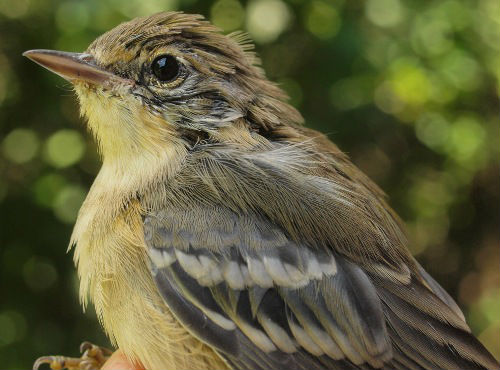
Although Pine Warblers nest immediately adjacent to MBO in the Morgan Arboretum, they remain among the species least frequently banded during our programs – the one above was only the third individual in ten years! In contrast, below is one of the 8 Blackpoll Warblers also banded this week.
(Photos by Simon Duval)
Over a two-day span in the middle of this week (Aug 30-31) we added three species to the list of birds observed at MBO this year – Wilson’s Snipe, Northern Goshawk, and Red-bellied Woodpecker. One day earlier, we banded our first Pine Warbler of 2014.
| # individuals banded | mean # individuals observed daily |
|---|---|
| 1. Tennessee Warbler (47) [1] | 1. American Robin (46) [1] |
| 2. Magnolia Warbler (40) [2] | 2. American Crow (43) [3] |
| 3. Red-eyed Vireo (23) [9] | 3. American Goldfinch (30) [2] |
| 4. Common Yellowthroat (12) [4] | 4. Cedar Waxwing (23) [4] |
| 5. Ovenbird (10) [-] | 5. Blue Jay (20) [8] |
| 5. American Redstart (10) [5] | 6. Black-capped Chickadee (19) [5] |
| 7. Blackpoll Warbler (8) [-] | 7. Canada Goose (11) [-] |
| 7. American Goldfinch (8) [-] | 8. Magnolia Warbler (11) [10] |
| 9. Yellow-bellied Flycatcher (7) [5] | 9. Tennessee Warbler (10) [7] |
| 9. Veery (7) [-] 9. Gray Catbird (7) [-] |
10. Red-eyed Vireo (10) [9] |
The top two species banded this week remained unchanged from week 4, and even the numbers were quite similar. This marks the second year in a row that Tennessee Warbler edged out Magnolia Warbler for top spot, compared to all eight previous years when Magnolia Warbler dominated without fail. Red-eyed Vireo jumped up to third place this week, during what has over the years been the peak of migration for the species. The season total for Red-eyed Vireo is now at 62, well above average, and on pace for close to 100 individuals if numbers are average for the remainder of September. Common Yellowthroats continued in fairly good numbers this week, and Ovenbird returned to the top ten after a one-week absence, tied for fifth place with American Redstart, which has reached a season total of 105 to date, and appears on the way to another fall total in the 140 to 150 range, as has been the case for the past four years. Blackpoll Warblers made their first appearance in the top ten this fall, tied with American Goldfinch for seventh place. The Yellow-bellied Flycatcher migration was strong for a second week in a row, and we now have a new season record for this species. Rounding out the list, we had the return of Gray Catbirds, which were quiet last week, and a late surge of Veery, usually an August migrant at MBO.
Yet again, American Robin topped the list of species observed this week, and the numbers are now building too. American Crow, American Goldfinch, and Cedar Waxwing all also increased this week, but remained in the second through fourth positions. Blue Jay flocks are growing too, enough to rise into the top five. Black-capped Chickadees remained fairly steady, as did Magnolia Warbler, Tennessee Warbler, and Red-eyed Vireo. Canada Goose made its first appearance in the top ten this fall, and no doubt will continue to increase as the season progresses.
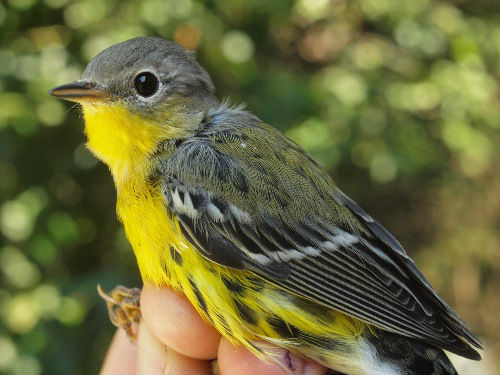 We are in the peak of Magnolia Warbler migration – and also have received the results of our analysis of blood-testing of individuals from the past couple of years. In brief, our data suggest that in many cases it is possible to reliably separate male and female hatch-year individuals by plumage … details to follow once we crunch the numbers further. |
Week 6: September 5-11, 2014
[
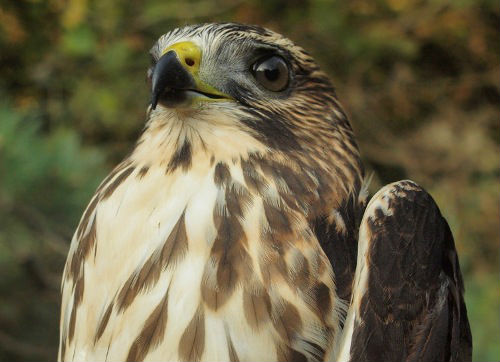 In terms of absolute numbers, Broad-winged Hawk is the most abundant raptor observed ] |
| THIS WEEK | THIS FALL | 2006 TOTAL | SITE TOTAL | |
|---|---|---|---|---|
| # birds (and species) banded | 223 (40) | 1269 (61) | 2768 (81) | 49078 (115) |
| # birds (and species) repeat | 69 (19) | 315 (36) | 654 (50) | 9788 (70) |
| # birds (and species) return | 2 (2) | 35 (16) | 175 (30) | 1609 (38) |
| # species observed | 85 | 120 | 151 | 209 |
| # net hours | 474.0 | 1240.1 | 1240.1 | 80423.4 |
| # birds banded / 100 net hours | 47.0 | 46.3 | 36.3 | 58.1 |
Note: table does not include nocturnal banding (owls)
Bander-in-charge:Simon Duval and Gay Gruner .
Assistants:Angelika Aleksieva, Veronica Aponte, Cindy Bouchard, Manon Bourdon, Claude Cloutier, David Davey, Jean Demers, Leah den Besten, Barbara Frei, Marcel Gahbauer, Pedro Grillo, Alison Hackney, Lisa Keelty, Helen Kohler, Marcel Lebeau, Catherine Legault, Valentin Lucet, Barbara MacDuff, Betsy McFarlane, Ana Morales, Clémence Soulard, Patricia Stotland, Sophie Tessier, Elise Titman, Rodger Titman, Christiane Tremblay.
Notes: The volume of migration in week 6 has varied greatly over the years, with as few as 109 and as many as 416 birds banded; this year’s count was somewhat below average, and the season total to date is lower than it has been at this point in the season since 2009. However, the number of species observed remains well above average for another week. The 69 repeats this week was a record high for week 6, so we were quite busy, even though a lot of the action was repeat visits from birds stopping over at MBO for a bit before resuming their southward migration..
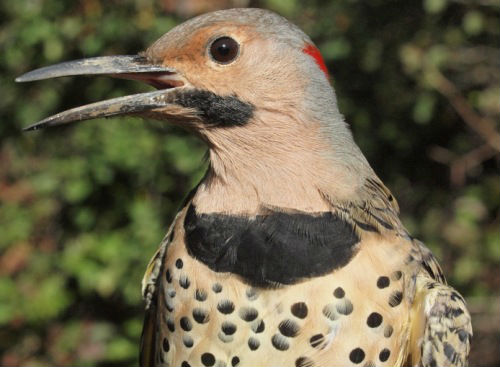
Last fall we did not band a single Yellow-shafted Flicker; this year our count is already up to three, including this and one other over the past week.
(Photo by Simon Duval)
While we did not observe any new species for the year this week, we added two raptors to our tally of species banded at MBO in 2014 – Sharp-shinned Hawk and Broad-winged Hawk … and the latter was our first ever, increasing our site total to 115 species banded. Over the course of the week we also banded the first Warbling Vireo of fall (long overdue – usually present in early August), as well as Chipping and Lincoln’s Sparrow.
| # individuals banded | mean # individuals observed daily |
|---|---|
| 1. American Goldfinch (44) [7] | 1. American Goldfinch (34) [1] |
| 2. Magnolia Warbler (27) [2] | 2. American Robin (27) [3] |
| 3. Red-eyed Vireo (26) [3] | 3. American Crow (24) [2] |
| 4. Tennessee Warbler (12) [1] | 4. Black-capped Chickadee (18) [4] |
| 5. Gray Catbird (11) [9] | 5. Cedar Waxwing (16) [8] |
| 5. American Redstart (11) [5] | 6. Canada Goose (16) [5] |
| 7. White-throated Sparrow (10) [-] | 7. Blue Jay (14) [-] |
| 8. Northern Waterthrush (8) [-] | 8. Red-eyed Vireo (9) [10] |
| 9. Black-capped Chickadee (7) [-] | 9. Gray Catbird (8) [7] |
| 10. Ovenbird (6) [5] 10. Common Yellowthroat (6) [4] 10. Song Sparrow(6) [-] |
9. Magnolia Warbler (8) [9] |
There was quite a shake-up in migration this week, with American Goldfinch making a sudden leap to the top of the list – quite a surprise in that in more than half of previous years, it was not even among the top ten species at this time of year, and the highest count for week 6 until now was 20 individuals banded in 2007. Magnolia Warbler, which was the top species in week 6 in seven of nine previous years, held steady from last week in second place, but Tennessee Warbler tapered off considerably from last week. Meanwhile Red-eyed Vireo numbers remained well above average, with the season total rising to 88, already the third highest fall total, and with more no doubt yet to come. Similarly, Gray Catbird is on a great pace, with 58 banded already this fall, getting close to the season record of 64, and with at least a few more weeks before their migration ends. It was a bit surprising to have another 7 “new” chickadees at this point in the season … perhaps local dispersal, or maybe an early sign of a chickadee migration to come this fall.
For just the second time this season, American Robin got pushed back to second place on the list of species observed, but for the third week in a row it was joined in the top three by American Goldfinch and American Crow. The middle of the pack was occupied by the same four species as last week – Black-capped Chickadee, Blue Jay, Cedar Waxwing, and Canada Goose, while Magnolia Warbler and Red-eyed Vireo remained in the bottom part of the top ten – the only change being the addition of Gray Catbird in place of Tennessee Warbler.
Week 7: September 12-18, 2014
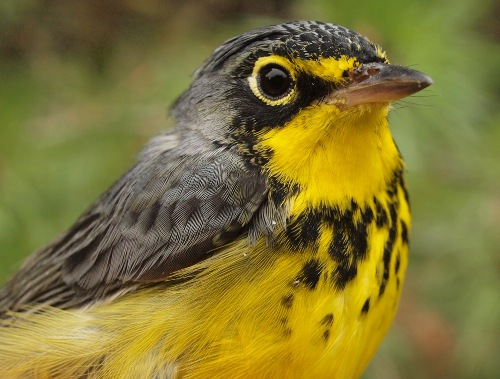 Canada Warblers are primarily an August migrant at MBO in fall, but we still got the one
|
Note: table does not include nocturnal banding (owls)
Bander-in-charge:Simon Duval and Gay Gruner .
Assistants:Angelika Aleksieva, Sue Bishop, Cindy Bouchard, Iain Caldwell, Luke Currin, David Davey, Jean Demers, Leah den Besten, Marianna Dimauro, Nathalie Gendron, Pedro Grillo, Nicole Guido, Alison Hackney, Lisa Keelty, Helen Kohler, Marcel Lebeau, Catherine Legault, Valentin Lucet, Betsy McFarlane, Ana Morales, Benoît Piquette, Catherine Russell, Ahmad Shah, Clémence Soulard, Elise Titman, Rodger Titman, Christiane Tremblay, Jay VanderGaast, Yifu Wang.
Notes: Migration picked up noticeably this week, with 324 birds of 41 species banded, both slightly above average for this middle week of the Fall Migration Monitoring Program. However, for a second straight week we had a record number of repeats for the period, suggesting that unusually many migrants are stopping over at MBO for at least a second day. The 90 species observed this week was just barely below the record count of 91 at this time last year..
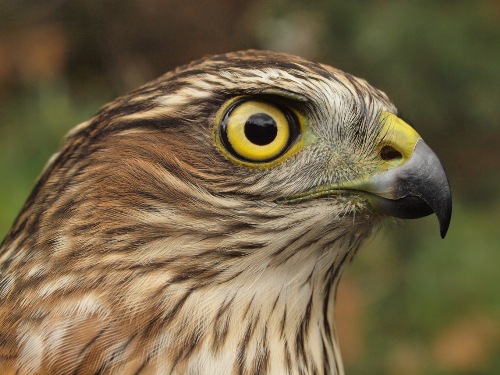
Until recently it was an unusually quiet fall for Sharp-shinned Hawks at MBO, but with one last week and another five this week, numbers are now close to average for the season.
(Photo by Simon Duval)
Again this week we did not add any new species for the year in terms of observations, but banded two species for the first time in 2014 – Blue-headed Vireo and Gray-cheeked Thrush. In addition, we banded our first Winter Wren and Yellow-rumped Warbler of the fall. The Blue-headed Vireo and Gray-cheeked Thrush were also the first observed this fall, and that was the case as well for Orange-crowned Warbler (our 24th warbler species of the season) and Rusty Blackbird.
| # individuals banded | mean # individuals observed daily |
|---|---|
| 1. Magnolia Warbler (94) [2] | 1. European Starling (175) [-] |
| 2. Nashville Warbler (26) [-] | 2. Canada Goose (137) [6] |
| 3. Red-eyed Vireo (23) [3] | 3. Common Grackle (108) [-] |
| 4. Tennessee Warbler (14) [4] | 4. American Crow (75) [3] |
| 5. Gray Catbird (13) [5] | 5. Ring-billed Gull (63) [-] |
| 5. American Redstart (13) [5] | 6. Broad-winged Hawk (50) [-] |
| 5. White-throated Sparrow (13) [7] | 7. Red-winged Blackbird (31) [-] |
| 8. Wilson’s Warbler (12) [-] | 8. Blue Jay (29) [7] |
| 9. American Goldfinch (11) [1] | 9. American Robin (25) [2] |
| 10. Common Yellowthroat (10) [10] | 10. American Goldfinch (23) [1] |
This was a big week for Magnolia Warbler, with more than three times as many of them banded as any other species. While Magnolia Warbler has been the top species banded in week 7 four times previously (2008, 2010, 2011, 2013), the 94 individuals banded was a new high, eclipsing the 84 from this time last year, and more than double the next closest total of 46 in 2008. Nashville Warbler moved up into second place, with the highest count for week 7 since 2005 when we had a strong movement of 38 individuals banded. The strong migration of Red-eyed Vireos continues unabated, in third place for a third week in a row, and with the season total now up to 111 individuals, just short of the record of 117 set in our first full fall in 2005. Like Nashville Warbler, it was the highest count of Red-eyed Vireos in week 7 since 2005. Meanwhile, Gray Catbird is a step ahead, and has already set a new season record as of this week – how high will the new total go?
The top species observed this week reflect a substantial change over previous weeks. European Starling has not been in the top ten at all this season, yet shot right to the top this week with a mean daily count of 175 individuals. It has not been common at this time of year in most past years either, appearing in the top ten for week 7 in just one-third of previous fall seasons, and with a top mean daily count of 75 in 2013. Starlings weren’t the only birds this week shooting up in abundance – Canada Goose increased nearly tenfold over last week, and Common Grackle also rocketed back into prominence with over 100 per day on average. American Crow dropped one spot in the rankings despite doubling in numbers, while Ring-billed Gull and Broad-winged Hawk also were new additions to the top ten, with mean daily counts of 50 or more individuals – impressive in that until this week, no species had reached that count over the course of a week, and this week six species did. Rounding out the list of the five new additions to the list this week, Red-winged Blackbird came in seventh place, and is sure to increase further as the season progresses. Blue Jay numbers also doubled from last week. American Robin numbers are similar to where they have been for most of the season, but got pushed down the list this week by virtue of all the new species arriving in large numbers.
Week 8: September 19-25, 2014
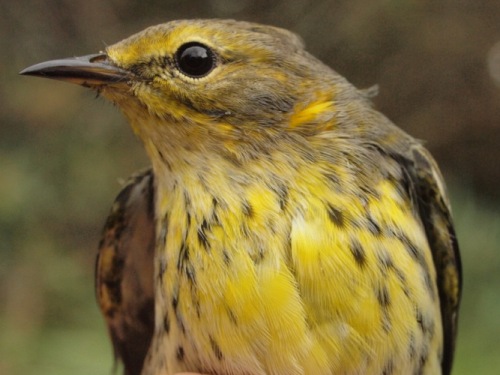 Although Cape May Warblers were abundant in parts of Quebec this summer (most
|
Note: table does not include nocturnal banding (owls)
Bander-in-charge:Simon Duval and Gay Gruner .
Assistants:Angelika Aleksieva, Nicolas Bernier, Sue Bishop, Marc Boisvert, Cindy Bouchard, Manon Bourdon, Iain Caldwell, Luke Currin, David Davey, Jean Demers, Nathalie Gendron, Pedro Grillo, Alison Hackney, Lisa Keelty, Marcel Lebeau, Catherine Legault, Betsy McFarlane, Ana Morales, Ahmad Shah, Marilou Skelling, Clémence Soulard, Elise Titman, Rodger Titman, Christiane Tremblay, Jay VanderGaast.
Notes: In four of the past five years, week 8 has unfolded relatively modestly, with between 205 and 252 birds banded during the week (the one notable exception being in 2010 when the total rose to an incredible 1279 thanks to an unprecedented influx of Yellow-rumped Warblers). As such, the 323 birds banded this week was more than we were expecting, though far short of being a record. Overall, the total for the season is hovering near our average pace, but with migration picking up this week, there is plenty of time yet for the numbers to grow. As with most of the season, the number of species observed this week was also somewhat above average..
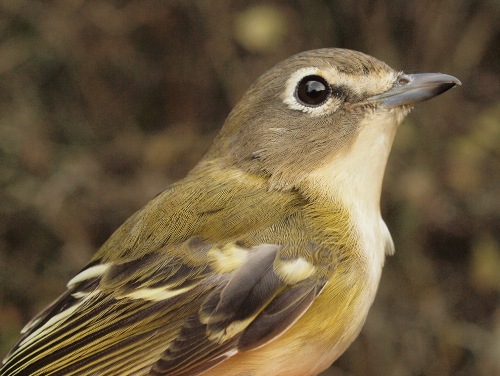
As banders, we always have to be aware of the potential for rarities – including some that differ only in subtle ways from more common species. This Blue-headed Vireo had us thinking about Cassin’s Vireo for a bit, due to the greenish head and back, but the contrast between the cheek and throat was enough to convince us it was just a somewhat differently coloured variant of our “regular” vireo.
(Photo by Simon Duval)
Our first Pine Siskin sighting of 2014 came on September 23; additionally, Brown Creeper, Fox Sparrow, and White-crowned Sparrow were spotted for the first time this fall. The only species banded for the first time this year was Palm Warbler, while Brown Creeper, Golden-crowned Kinglet, and White-crowned Sparrow were new for the season.
| # individuals banded | mean # individuals observed daily |
|---|---|
| 1. White-throated Sparrow (66) [5] | 1. Canada Goose (601) [2] |
| 2. Magnolia Warbler (42) [1] | 2. Common Grackle (198) [3] |
| 3. Ruby-crowned Kinglet (21) [-] | 3. European Starling (124) [1] |
| 4. Blue Jay (17) [-] | 4. White-throated Sparrow (57) [-] |
| 5. Swainson’s Thrush (16) [-] | 5. Red-winged Blackbird (44) [7] |
| 6. Nashville Warbler (15) [2] | 6. Blue Jay (40) [8] |
| 7. Golden-crowned Kinglet (14) [-] | 7. American Crow (39) [4] |
| 8. Yellow-rumped Warbler (12) [-] | 8. American Robin (30) [9] |
| 8. Black-throated Blue Warbler (12) [-] | 9. Black-capped Chickadee (16) [-] |
| 10. Red-eyed Vireo (10) [3] | 10. Ring-billed Gull (12) [-] |
There was a drastic change this week in the top ten species banded, with only four of last week’s species carrying over. For the third year in a row, White-throated Sparrow was the dominant species in week 8. Magnolia Warbler filled that spot in 2011, but after leading the way at MBO for the past couple of weeks, dropped to second place this week. Last week’s runner-up, Nashville Warbler, dropped to sixth place this week, and Red-eyed Vireo dropped from third place to tenth – though the additional 10 individuals banded this week were enough to result in a new fall record, passing the 117 banded in our first full fall season in 2005. Meanwhile, Yellow-rumped Warbler was the top species for week 8 by a wide margin in each of 2006, 2008, and 2010 – though not even in the top ten for the week the past two years! This year was a bit in between, with just enough banded to show up in the lower half of the list. Among the other newcomers to the top ten this week were the two kinglets, arriving right on schedule; Blue Jay, moving in big numbers this fall; and Black-throated Blue Warbler, a species that has a protracted migration through MBO but rarely is in large enough numbers to crack the top ten in any given week.
With respect to birds observed, Canada Goose rose to top place this week, with a mean daily count of over 600 individuals. This is the sixth time in the past seven years that Canada Goose has been the top species in week 8; the only exception was in 2010 when the Yellow-rumped Warbler invasion was strong enough to propel that species ahead of the geese. However, the past four years the goose numbers have been lower at this time of year (mean daily counts of 93 to 283). Common Grackle flocks were also surprisingly large this week. Usually the species peaks later in fall – in the past four years, grackles were never in the top ten during week 8, let alone near the top of the list. However, back in 2005, we had a higher mean daily count (334) during this week, so their appearance at this time is not unprecedented. Joining the grackle invasion were the European Starlings, also earlier than normal – only three times before have we noted them in the top ten in week 8, and the previous high mean daily count was one-quarter of this year’s level (31 vs. 124). Not surprisingly, there were also Red-winged Blackbirds mixed in with the grackles and starlings, in above-average numbers for late September. Corresponding to the influx of White-throated Sparrows banded, the number observed daily rose to an average of 57 – similar to the numbers we observed in week 8 in 2010 and 2012, but much higher than in all other years. Similarly, Blue Jay numbers are typically quite predictable at this time of year (mean daily counts between 18 and 26 in 7 of 9 previous years), but were roughly three times higher in 2010 and 2012, and close to double this year … just enough to be marginally more abundant this week than American Crow. Rounding out this week’s top ten were American Robin, Black-capped Chickadee, and Ring-billed Gull.
 September is a great time for studying sparrows – in this case we have a line-up (from left to right) of White-crowned, White-throated, Swamp, and Lincoln’s. |
Week 9: September 26 – October 2, 2014
[
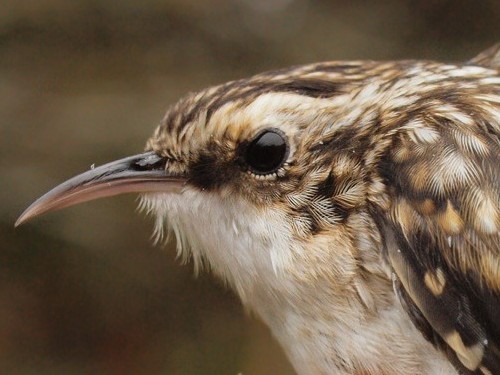 We always enjoy the opportunity to see Brown Creepers up close – but this was a special one, the 50,000th bird banded at MBO in our ten-year history. ] |
| THIS WEEK | THIS FALL | 2006 TOTAL | SITE TOTAL | |
|---|---|---|---|---|
| # birds (and species) banded | 454 (37) | 2369 (70) | 3868 n(84) | 50178 (115) |
| # birds (and species) repeat | 76 (17) | 534 (45) | 873 (55) | 10007 (70) |
| # birds (and species) return | 5 (4) | 49 917) | 189 (31) | 1623 (38) |
| # species observed | 84 | 134 | 157 | 209 |
| # net hours | 541.0 | 4652.0 | 8065.4 | 87248.7 |
| # birds banded / 100 net hours | 83.9 | 50.9 | 48.0 | 57.5 |
Note: table does not include nocturnal banding (owls)
Bander-in-charge:Simon Duval and Gay Gruner .
Assistants:Angelika Aleksieva, Nicolas Bernier, Sue Bishop, Cindy Bouchard, Iain Caldwell, Luke Currin, David Davey, Jean Demers, Marianna Dimauro, Steve Dumont, Nathalie Gendron, Mathilde Guglielmi, Alison Hackney, Lisa Keelty, Marcel Lebeau, Valentin Lucet, Betsy McFarlane, Ana Morales, Catherine Russell, Ahmad Shah, Clémence Soulard, Elise Titman, Rodger Titman, Christiane Tremblay.
Notes: This was the busiest week of banding at MBO in 2014, and the highest total for week 9 since 2010. As a result, the season total is now ahead of all previous years except 2008, 2010, and 2012 – even though Yellow-rumped Warblers were the big driver behind the high counts in 2008 and 2010, we are seeing in the 2012 and 2014 totals a continuing pattern of above-average numbers overall in the “even” years. Most notably though, this week we reached a significant milestone, banding our 50,000th bird on September 30 (and just two days later, recording our 10,000th repeat)..
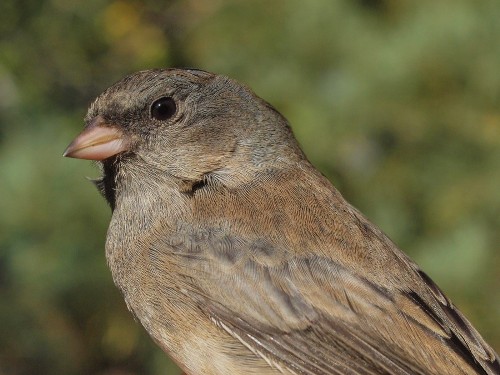
Although often thought of as a bird of winter, Slate-colored Juncos have already started to arrive at MBO.
(Photo by Simon Duval)
This was the busiest week of banding at MBO in 2014, and the highest total for week 9 since 2010. As a result, the season total is now ahead of all previous years except 2008, 2010, and 2012 – even though Yellow-rumped Warblers were the big driver behind the high counts in 2008 and 2010, we are seeing in the 2012 and 2014 totals a continuing pattern of above-average numbers overall in the “even” years. Most notably though, this week we reached a significant milestone, banding our 50,000th bird on September 30 (and just two days later, recording our 10,000th repeat).
| # individuals banded | mean # individuals observed daily |
|---|---|
| 1. White-throated Sparrow (88) [1] | 1. Canada Goose (518) [1] |
| 2. Yellow-rumped Warbler (85) [8] | 2. European Starling (74) [3] |
| 3. Ruby-crowned Kinglet (45) [3] | 3. Red-winged Blackbird (68) [5] |
| 4. Golden-crowned Kinglet (32) [7] | 4. White-throated Sparrow (62) [4] |
| 5. Blue Jay (23) [4] | 5. Common Grackle (60) [2] |
| 5. Slate-colored Junco (23) [-] | 6. American Crow (48) [7] |
| 7. Magnolia Warbler (19) [2] | 7. Yellow-rumped Warbler (38) [-] |
| 8. Song Sparrow (14) [-] | 8. American Robin (37) [8] |
| 9. Nashville Warbler (12) [6] | 9. Blue Jay (28) [6] |
| 9. American Goldfinch (12) [-] | 10. Ring-billed Gull (21) [10] 10. Black-capped Chickadee (21) [9] |
White-throated Sparrow remained the top species banded this week, albeit by a narrow margin ahead of Yellow-rumped Warbler. This means that in both weeks 8 and 9, White-throated Sparrow has been number 1 in 2005, 2007, 2009, and 2012-2014 – a remarkably consistent pattern. Even more notably, the count of White-throated Sparrows in week 9 has been between 88 and 112 in each of those years, except for a lower total of 55 last fall. We were wondering what Yellow-rumped Warbler numbers would be like this fall, given strong peaks in 2006, 2008, and 2010, but a more modest high in 2012. Although this week’s total of 85 was nearly the same as in 2012 (84) and much higher than in the “odd” years (ranging from 12 to 33 banded in week 9), numbers already seemed to be tapering off late in the week, and we suspect the season total will be lower than in 2012. Both kinglets increased this week, as we approach their traditional early/mid-October peak. We have now banded 40 Blue Jays over the past two weeks, which is more than in all but two previous entire fall migration monitoring periods. Perhaps the biggest surprise this week was the total of 23 Slate-colored Juncos – this is a late-season migrant at MBO, and our previous high for week 9 was 17 (in 2005); in 50% of years to date, it has not even been among the top ten species at this point in the season. At the same time, Magnolia Warblers are still around in decent numbers, with the season total approaching last year’s record of 284, but likely to fall just short. Also tapering off as we move into October is Nashville Warbler, while Song Sparrow and American Goldfinch returned to the top ten this week.
For the tenth year in a row, Canada Goose was the most abundant species observed in week 10, and the numbers this week were close to average. Last week’s mixed blackbird flocks (European Starling, Common Grackle, and Red-winged Blackbird) tapered off a bit this week, but still managed to be three of the five most abundant species observed. Holding steady in fourth place was White-throated Sparrow, in roughly typical numbers for this time of year. Yellow-rumped Warblers were sufficiently abundant this week to enter the top ten for the first time this fall. The Blue Jay migration appears to be starting to taper off, despite the high number banded this week, while American Robins are building to their traditional late October peak. Like last week, Black-capped Chickadee and Ring-billed Gull rounded out the bottom of the top ten.
Meanwhile, our Northern Saw-whet Owl migration monitoring program kicked off for another year this week. We had our most steady “opening week” ever, with owls banded every night, and a strong total of 28 for the week. Our busiest night was October 1, with 11 owls banded. Considering that we had heard of poor nesting success in parts of Quebec, this is a very encouraging start to our season.
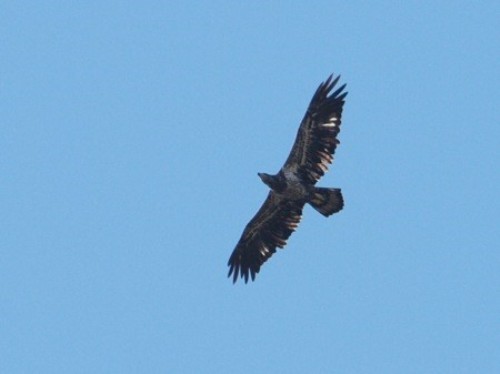 As much as the focus at MBO tends to be on songbirds, we do try to keep an eye on the skies as well, to document raptor migration. One of this week’s highlights was this subadult II Bald Eagle. |
Week 10: October 3 – 9, 2014
[
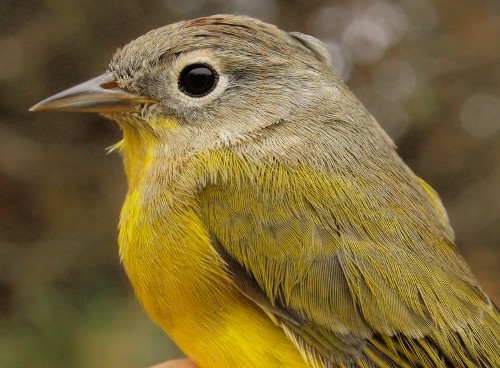 Nashville Warblers are still on the move, with over 100 banded so far this fall. Even though it is now October, we still observed 12 warbler species this week (the others being Tennessee, Orange-crowned, Cape May, Black-throated Blue, Yellow-rumped, Black-throated Green, Palm, Black-and-white, Wilson’s, American Redstart, and Common Yellowthroat). Given that most of them will not be seen again until spring, we dedicate this week’s photos to a selction of these warblers. ] |
| THIS WEEK | THIS FALL | 2006 TOTAL | SITE TOTAL | |
|---|---|---|---|---|
| # birds (and species) banded | 295 (31) | 2664 (73) | 4163 (85) | 50473 (115) |
| # birds (and species) repeat | 64 (14) | 598 (45) | 937 (55) | 10071 (70) |
| # birds (and species) return | 2 (1) | 51 (17) | 191 (31) | 1625 (38) |
| # species observed | 74 | 136 | 158 | 209 |
| # net hours | 328.0 | 4980.0 | 8393.4 | 87576.7 |
| # birds banded / 100 net hours | 89.9 | 53.5 | 49.6 | 57.6 |
Note: table does not include nocturnal banding (owls)
Bander-in-charge:Simon Duval and Gay Gruner .
Assistants:
Sue Bishop, Cindy Bouchard, Iain Caldwell, Claude Cloutier, Luke Currin, David Davey, Steve Dumont, Marcel Gahbauer, Nathalie Gendron, Thierry Grandmont, Alison Hackney, Lisa Keelty, Helen Kohler, Lance Laviolette, Marcel Lebeau, Betsy McFarlane, Ana Morales, Greg Rand, Shawna Sevigny, Ahmad Shah, Patricia Stotland, Elise Titman, Rodger Titman, Christiane Tremblay.
Notes:
After two strong weeks of migration, numbers were down in week 10 – the 295 birds banded was fewer than in any previous year except 2011, when we had just 275. However, this week’s results were in large part constrained by rain, which reduced our normal level of effort by roughly 40%. The rate of birds banded per 100 net hours was actually higher this week than any other week this fall. The weather also put a bit of a damper on observations, although the 74 species detected this week was close to our long-term average for this point in the season .

Nashville Warblers are still on the move, with over 100 banded so far this fall. Even though it is now October, we still observed 12 warbler species this week (the others being Tennessee, Orange-crowned, Cape May, Black-throated Blue, Yellow-rumped, Black-throated Green, Palm, Black-and-white, Wilson’s, American Redstart, and Common Yellowthroat). Given that most of them will not be seen again until spring, we dedicate this week’s photos to a selction of these warblers. (Photo by Simon Duval)
Peregrine Falcon sightings at MBO are always infrequent, but traditionally have peaked in early October; sure enough, our first sighting of the year came on October 3. The same day we also saw our first “Yellow” Palm Warbler of the year, and banded our first Savannah Sparrow of 2014. Additionally we saw our first Orange-crowned Warbler and Fox Sparrow of the fall this week .
| # individuals banded | mean # individuals observed daily |
|---|---|
| 1. Ruby-crowned Kinglet (81) [3] | 1. Canada Goose (439) [1] |
| 2. White-throated Sparrow (79) [1] | 2. Red-winged Blackbird (122) [3] |
| 3. Yellow-rumped Warbler (34) [2] | 3. White-throated Sparrow (81) [4] |
| 4. Slate-colored Junco (14) [5] | 4. Common Grackle (73) [5] |
| 5. Nashville Warbler (11) [9] | 5. American Robin (62) [8] |
| 6. Blue Jay (9) [5] | 6. European Starling (58) [2] |
| 7. Song Sparrow (8) [8] | 7. American Crow (43) [6] |
| 8. Black-capped Chickadee (6) [-] | 8. Ruby-crowned Kinglet (31) [-] |
| 8. Golden-crowned Kinglet (6) [4] | 9. Yellow-rumped Warbler (28) [7] |
| 8. White-crowned Sparrow (6) [-] | 10. Blue Jay (21) [9] |
The top three species banded this week are the ones that over the years have dominated week 10. Ruby-crowned Kinglet was the top species this time (as in 2006, 2007, 2009, and 2013), just narrowly edging out White-throated Sparrow, which was number one in 2005 and 2011. In 2008, 2010, and 2012, the big Yellow-rumped Warbler movements carried over through week 10, but this year the numbers were already down by more than half compared to last week. Slate-colored Junco and Nashville Warbler both increased in rank this week, despite the number of individuals banded declining from week 9. The continued movement of Blue Jays has pushed that species to a new fall record. The half-dozen Black-capped Chickadees banded this week suggests a modest movement of migrants. It was a bit surprising to see Golden-crowned Kinglet numbers drop so low at what is usually close to their peak of migration, but perhaps they will yet rebound next week.
Canada Goose remained the most abundant species observed for the third week in a row, and matches historical trends (only in 2012 were Common Grackles more numerous). The mixed blackbird flocks remained a significant presence at MBO this week, but with Red-winged Blackbirds becoming the most prominent species among them, and European Starling dropping back a bit. White-throated Sparrows often are starting to taper off in week 10, but this year the numbers actually continued to increase compared to last week. American Robin numbers are also still growing, while Blue Jays are now just hanging on at the bottom of the top ten.
Whereas our Saw-whet Owl banding season began very promisingly last week, the migration slowed to a trickle this week. Three nights were rained out, and even when we could operate our program the results were meagre, with between 0 and 3 owls nightly. We also had 4 repeats this week, an unusually high number – suggesting that migration has stalled.
Week 11: October 10 – 16, 2014
[
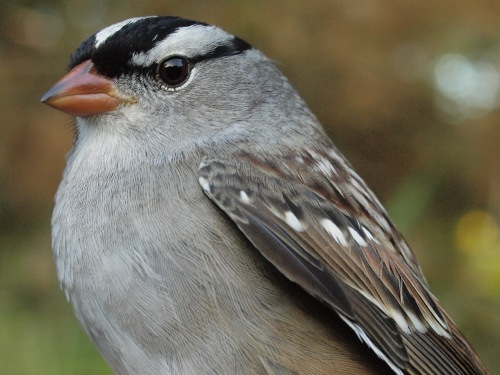 One week after we celebrated the last big push of warblers for the 2014 fall migration, this week it was sparrows that dominated, including five of the top ten species banded. One of those was five was a White-crowned Sparrow. (Photo by Simon Duval) ] |
| THIS WEEK | THIS FALL | 2006 TOTAL | SITE TOTAL | |
|---|---|---|---|---|
| # birds (and species) banded | 408 (25) | 3072 (73) | 4571 (85) | 50881 (115) |
| # birds (and species) repeat | 99 (14) | 697 (47) | 1036 (56) | 10170 (70) |
| # birds (and species) return | 2 (2) | 53 (18) | 193 (32) | 1627 (38) |
| # species observed | 75 | 143 | 161 | 209 |
| # net hours | 471.0 | 5451.0 | 8864.4 | 88047.7 |
| # birds banded / 100 net hours | 86.6 | 56.4 | 51.6 | 57.8 |
Note: table does not include nocturnal banding (owls)
Bander-in-charge:Simon Duval and Gay Gruner.
Assistants:Nicolas Bernier, Yvan Bernier, Sue Bishop, Marc Boisvert, Cindy Bouchard, Claude Cloutier, Luke Currin, David Davey, Jean Demers, Barbara Frei, Marcel Gahbauer, Nathalie Gendron, Alison Hackney, Marie-Anne Hudson, Lisa Keelty, Helen Kohler, Line Lamontagne, Andree Laviolette, Lance Laviolette, Marcel Lebeau, Valentin Lucet, Betsy McFarlane, Ana Morales, Benoît Piquette, Greg Rand, Lisa Rosenberger, Shawna Sevigny, Ahmad Shah, Clémence Soulard, Elise Titman, Rodger Titman, Christiane Tremblay, Jessica Turgeon.
Notes: Although the weather remained a bit unsettled this week, it was an improvement over week 10. It was also incredibly warm for this time of year, with daily maximum temperatures as high as 25 Celsius, almost unheard of in mid-October. Despite that, migration was strong, with the 408 birds banded this week well above average, and the highest for week 11 since 2010. The lingering warm weather may have been reflected more in the count of species observed this week – 75 set a new record for this period, far ahead of the 68 counted in week 11 of 2005. The season total to date of 143 is tied with last year for the highest count to this point in the season..
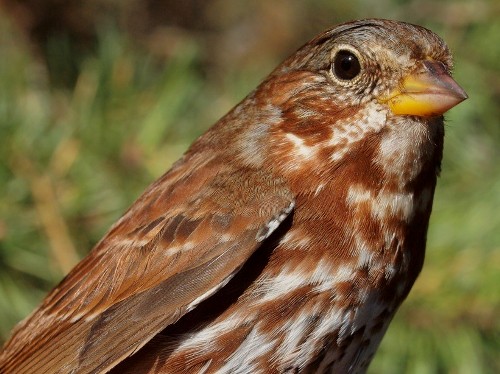
Fox Sparrows are always a sign that we are approaching the end of fall migration. (Photo by Simon Duval)
It was a good week at MBO for uncommon species, with Ruffed Grouse, Northern Mockingbird, and Eastern Towhee all observed for the first time in 2014. It was only our eleventh Ruffed Grouse sighting in MBO’s ten-year-history (and the first since March 2011), our fifth Northern Mockingbird (others 2005, 2007, and 2012), and our sixth Eastern Towhee (and first since May 2011). An additional four species were new for this fall – American Black Duck, American Woodcock, Great Black-backed Gull, and American Tree Sparrow. However, no species were banded this week that were new for the season.
| # individuals banded | mean # individuals observed daily |
|---|---|
| 1. White-throated Sparrow (127) [2] | 1. Canada Goose (285) [1] |
| 2. Ruby-crowned Kinglet (95) [1] | 2. Red-winged Blackbird (167) [2] |
| 3. Hermit Thrush (38) [-] | 3. White-throated Sparrow (94) [3] |
| 4. Slate-colored Junco (37) [4] | 4. American Robin (78) [5] |
| 5. Yellow-rumped Warbler (29) [3] | 5. European Starling (45) [6] |
| 6. Swamp Sparrow (12) [-] | 6. Common Grackle (38) [4] |
| 7. Golden-crowned Kinglet (10) [8] | 7. American Crow (33) [7] |
| 8. Fox Sparrow (9) [-] | 8. Ruby-crowned Kinglet (32) [8] |
| 9. Black-capped Chickadee (8) [8] | 9. Yellow-rumped Warbler (22) [9] |
| 9. White-crowned Sparrow (8) [8] | 10. Slate-colored Junco (18) [-] |
We were surprised this week to see White-throated Sparrow rebound to the top of the list of species banded, and with the highest weekly total of the fall at that. Over the years, the peak for the species has tended to alternate between weeks 9 and 10, almost always with a sharp drop-off in week 11. The lingering warm weather this fall may be facilitating the sparrows staying around longer than usual, although this may also reflect a trend of later migration, in that this is the third year in a row that a new record count has been established in week 11. In 2007, 2012, and 2013, Ruby-crowned Kinglet was banded most often in week 11, and this year it was in second place. After a relatively slow migration so far this fall, there was a dramatic influx of Hermit Thrush this week – nearly as many as in the record week in 2010. Slate-colored Junco and Yellow-rumped Warbler numbers remained relatively steady from last week, and were fairly typical for week 11. A new wave of Swamp Sparrows appeared to come through this week, while Fox Sparrows have started to arrive in decent numbers. Notably absent from the list is American Robin, which was in the top two from 2005 through 2009, but has been less prominent in week 11 over the past five years, perhaps also suggesting migration is shifting somewhat later.
The species observed this week were very similar to last week, with six species remaining in the same ranking in the top ten, and three others in the middle just shuffling amongst themselves. Canada Goose was the most abundant species again this week, as it was for week 11 in 2005, 2007, 2011, and 2013. Red-winged Blackbird was the runner-up, as in three of the previous four years, although in somewhat lower numbers than usual. White-throated Sparrow remained in third place, with a mean daily count 50% higher than the previous week 11 high of 63 set back in 2009. Meanwhile, although American Robin rose to fourth place this week, it was the lowest ever mean daily count for week 11. Overall, the top ten species observed were very similar to last week, reflecting the unseasonally warm weather that lingered through much of the period.
After the slowdown in owl migration last week, we were happy to see this week start off with 15 owls on the night of October 10, and another 14 the following night, plus a recapture of an owl that was banded in Pennsylvania. After that, numbers tapered off again, with 7 on October 12, and 2 on each of October 13 and 14, before rain moved in again, cancelling the final two nights of the week.
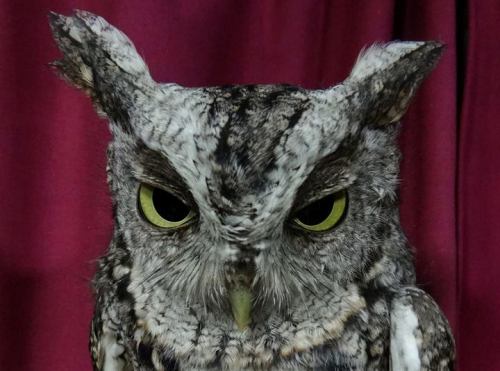 Although our focus is on Northern Saw-whet Owls, we are always happy to have the opportunity to band other species. This Eastern Screech-Owl was our first of this fall, and just our tenth individual over the years. (Photo by Simon Duval) 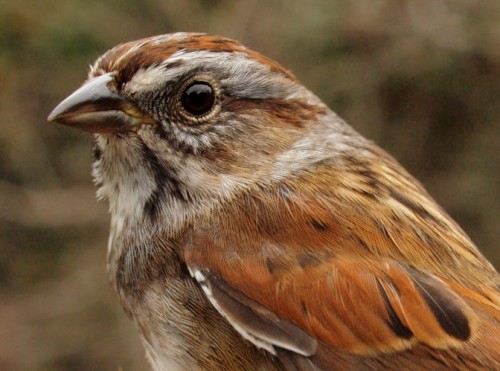 Swamp Sparrow is usually the fourth or fifth most abundant sparrow at MBO over the course of a fall season, but tends to go relatively unnoticed because their movement is relatively slow and steady throughout our monitoring period. This week there was a notable spike in numbers, with 12 individuals banded. (Photo by Simon Duval) |
Week 12 (October 17-23, 2014)
[
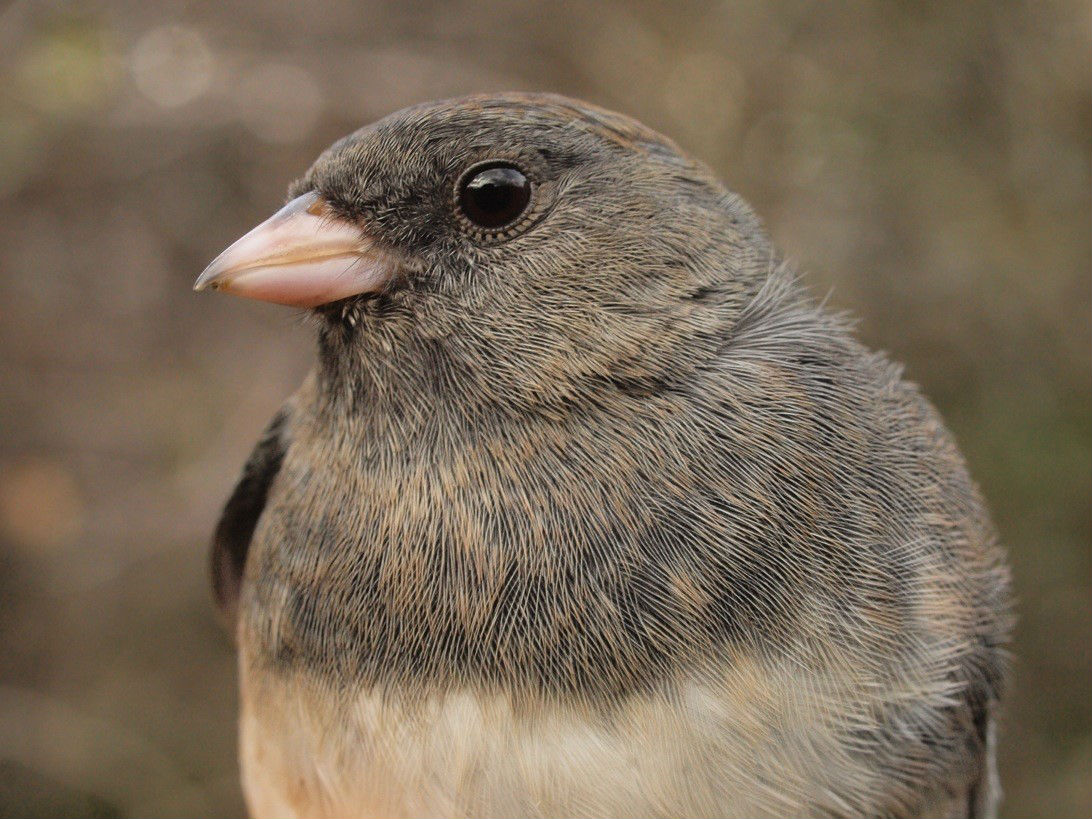 The 97 Slate-colored Juncos banded this week were the most in a one-week period since this time in 2010 (Photo by Simon Duval) ] |
| THIS WEEK | THIS FALL | 2006 TOTAL | SITE TOTAL | |
|---|---|---|---|---|
| # birds (and species) banded | 405(27) | 3841(75 | 5084(88) | 52308(119) |
| # birds (and species) repeat | 75(14) | 776(49) | 1131(58) | 10423(83) |
| # birds (and species) return | 3(2) | 58(18) | 198(32) | 1648(50) |
| # species observed | 64 | 145 | 160 | 209 |
| # net hours | 461.5 | 5934.7 | 10174.8 | 101274.3 |
| # birds banded / 100 net hours | 87.8 | 58.7 | 50.0 | 51.5 |
Note: table does not include nocturnal banding (owls)
Banders-in-charge: Nicolas Bernier, Simon Duval, Gay Gruner
Assistants: Sue Bishop, Cindy Bouchard, Iain Caldwell, Claude Cloutier, David Davey, Jean Demers, Mégane Déziel, Marianna Dimauro, Barbara Frei, Pedro Grillo, Alison Hackney, Frédéric Hareau, Lisa Keelty, Helen Kohler, Marcel Lebeau, Catherine Legault, Francine Marcoux, Betsy McFarlane, Anita Morales, Greg Rand, Catherine Russell, Ahmad Shah, Clémence Soulard, Patricia Stotland, Christiane Tremblay
Notes: The number of migrants moving through MBO remained high this week, with nearly as many birds banded this week as last; only once previously (in 2010) was there a higher total in week 12. However, diversity is starting to taper off, with 11 fewer species recorded this week compared to last. However, the cumulative total of 145 species since the start of fall is the second-highest ever at this point in the season. No doubt this week’s results were at least partly influenced by the continuing mild conditions that aren’t doing anything to push migrants farther south.
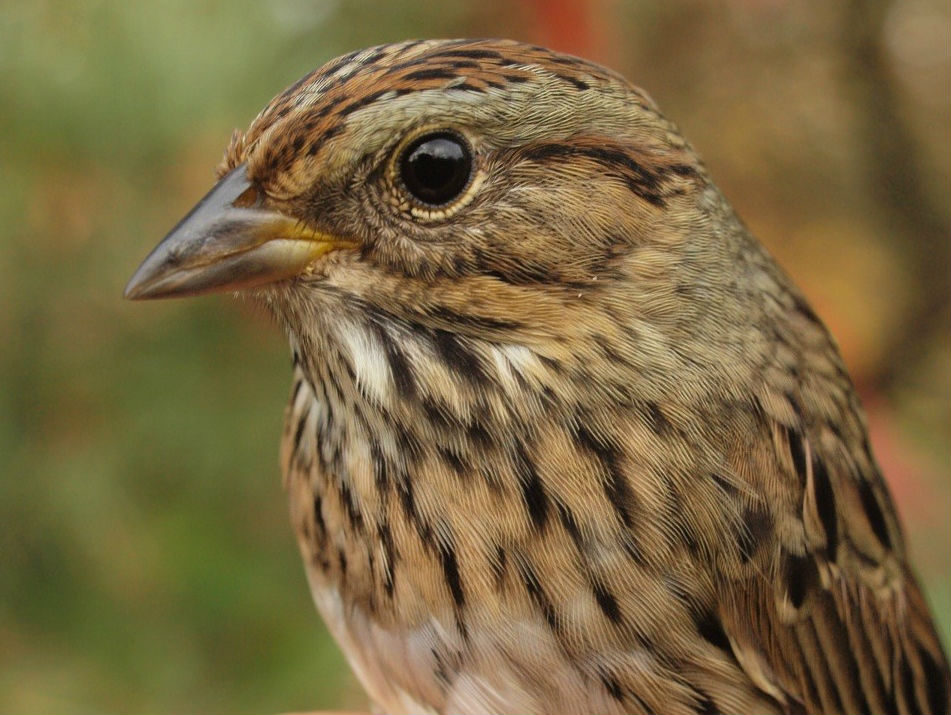
This was an unusually late Lincoln’s Sparrow – only one other has previously been banded this late in fall (Photo by Simon Duval)
By this point in fall it is more difficult to add ‘new’ species for the season. However, this week we observed Northern Saw-whet Owl for the first time during the day this fall (owl program records date back to week 9 of course), and we banded our first Northern Shrike of the year.
| # individuals banded | mean # individuals observed daily |
|---|---|
| 1. Slate-colored Junco (97) [4] | 1. Canada Goose (328) [1] |
| 2. Ruby-crowned Kinglet (65) [2] | 2. American Robin (185) [4] |
| 3. White-throated Sparrow (62) [1] | 3. Red-winged Blackbird (135) [2] |
| 4. American Robin (32) [-] | 4. American Crow (94) [7] |
| 5. Hermit Thrush (25) [3] | 5. Common Grackle (72) [6] |
| 6. American Tree Sparrow (23) [-] | 6. European Starling (72) [5] |
| 7. Fox Sparrow (15) [8] | 7. Slate-colored Junco (53) [10] |
| 8. Black-capped Chickadee (14) [9] | 8. White-throated Sparrow (53) [3 |
| 9. Golden-crowned Kinglet (12) [7] | 9. Ruby-crowned Kinglet (17) [8] |
| 10. Song Sparrow (11) [-] | 10. Blue Jay (16) [-] |
This week’s high banding totals were primarily driven by the top three species – Slate-colored Junco, Ruby-crowned Kinglet, and White-throated Sparrow, all of which are routinely among the most abundant birds for week 12. Two thrushes rounded out the top five, but one (American Robin) was scarcer than in any previous year except 2011, while the other (Hermit Thrush) exceeded the previous record high for the period, set in 2010. The bottom half of the top ten featured another three sparrow species, plus Black-capped Chickadee and Golden-crowned Kinglet.
With respect to observations, Canada Goose topped the list, as it has for week 12 in 5 of 9 previous years. American Robin numbers are building toward the end of the season as usual, and Red-winged Blackbirds remained present in large flocks, mixed at times with good numbers of Common Grackles and European Starlings. Slate-colored Junco and White-throated Sparrow were separated by just percentage points for seventh and eighth place, both of them more than three times as abundant as the remaining two species on the list – Ruby-crowned Kinglet and Blue Jay. This was only the fourth year in which Ruby-crowned Kinglet remained abundant enough this late in the season to show up among the top ten, and reflects the continuing warm weather.
On the owling front, another 36 Northern Saw-whet Owls were banded, and we had a lone foreign recovery.
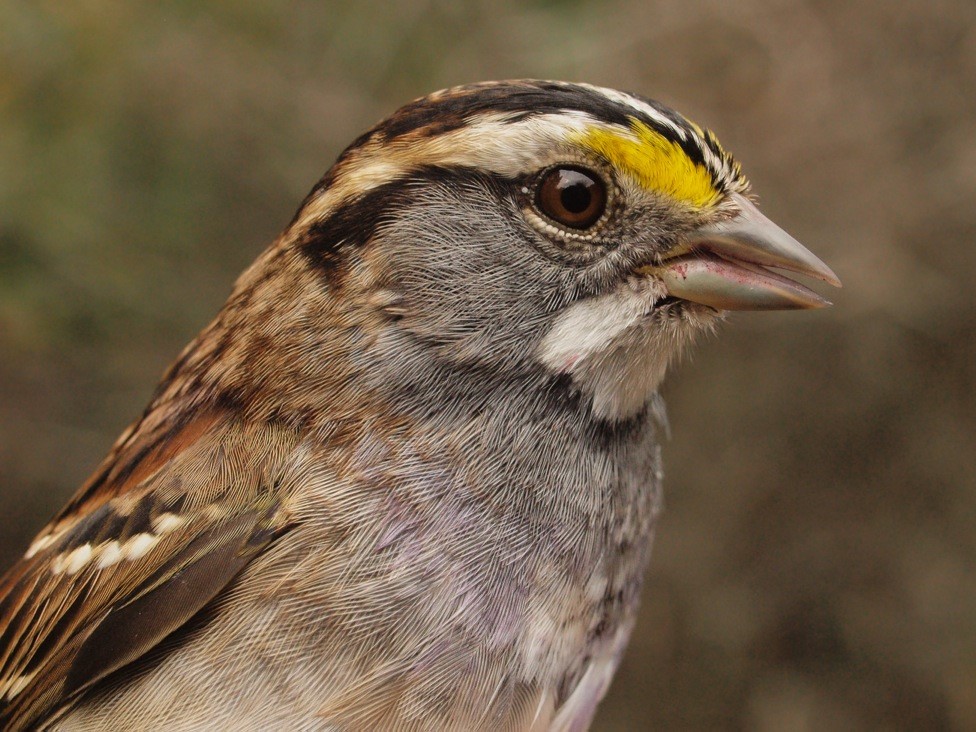 With another 62 individuals banded this week (over triple the previous long-term mean of 20 for week 12), White-throated Sparrow may be within reach of breaking the single season fall record of 506 banded, set in 2012 (Photo by Simon Duval) 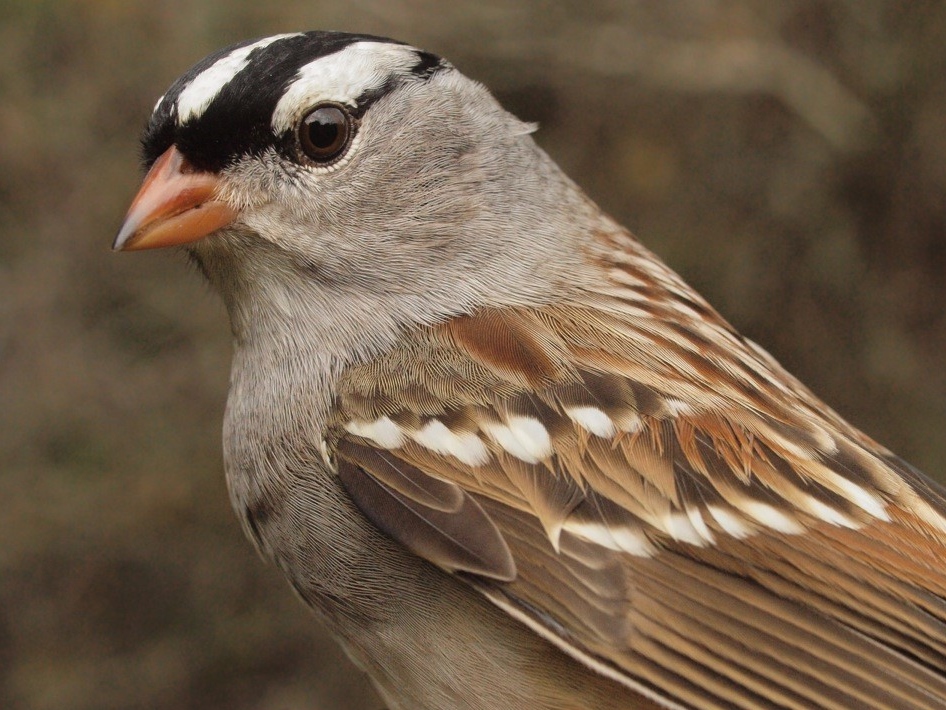 In contrast to White-throated Sparrow, White-crowned Sparrow numbers have been a bit below average this fall, although the total banded has rebounded somewhat from last year’s record low (Photo by Simon Duval) |
TitWeek 13 (October 24-30, 2014)le
[
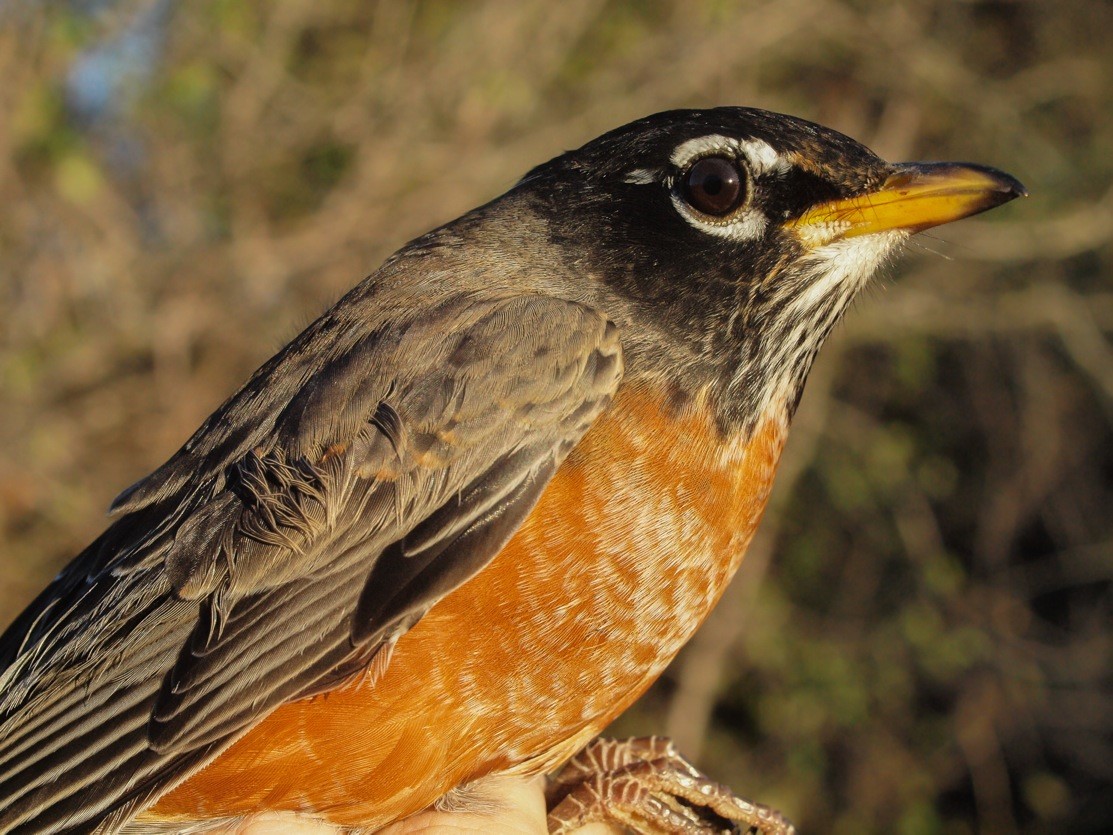 It was the week of the American Robin at MBO, with a record high mean daily count of 776 individuals (Photo by Simon Duval) ] |
| THIS WEEK | THIS FALL | 2006 TOTAL | SITE TOTAL | |
|---|---|---|---|---|
| # birds (and species) banded | 337(20) | 3818(77) | 5452(89) | 52676(119) |
| # birds (and species) repeat | 72(13) | 848(49) | 1208(58) | 10500(83) |
| # birds (and species) return | 3(3) | 61(20) | 201(32) | 1651(50) |
| # species observed | 70 | 150 | 165 | 209 |
| # net hours | 488.0 | 6422.7 | 10898.2 | 101997.7 |
| # birds banded / 100 net hours | 69.1 | 59.4 | 50.0 | 51.5 |
Note: table does not include nocturnal banding (owls)
Banders-in-charge: Nicolas Bernier, Simon Duval, Gay Gruner
Assistants: Angelika Aleksieva, Sue Bishop, Marc Boisvert, Cindy Bouchard, Iain Caldwell, Claude Cloutier, Luke Currin, David Davey, Jean Demers, Marianna Dimauro, Alison Hackney, Lisa Keelty, Helen Kohler, Marcel Lebeau, Francine Marcoux, Betsy McFarlane, Anita Morales, Greg Rand, Catherine Russell, Ahmad Shah, Clémence Soulard, Patricia Stotland, Elise Titman, Rodger Titman, Christiane Tremblay
Notes: The 2014 Fall Migration Monitoring Program wrapped up on a strong note, with another 337 birds banded this week, maintaining the above average trend that has been the case for much of the season. However, recognizing that weather remained unusually mild for much of this week and we are seeing a number of species linger later than usual, we will unofficially keep daily operations going for another full week, although results will be considered part of the winter program.
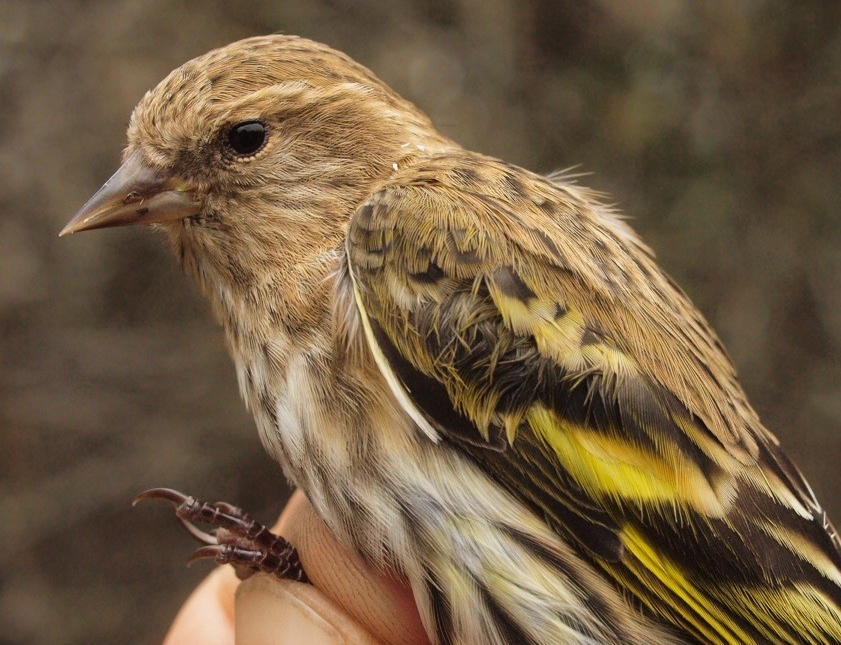
One of the Pine Siskins banded this week, the final “new” species of fall 2014 (Photo by Simon Duval)
As is often the case, week 13 brings a few new species in the form of late season migrants. This year those were Rough-legged Hawk, Golden Eagle, White-winged Crossbill, and Common Redpoll, which together increased our season total to 150 species observed, just one short of the fall record. We also banded Pine Siskin and ended up with 77 species banded during fall for the fourth time in ten years.
| # individuals banded | mean # individuals observed daily |
|---|---|
| 1. American Tree Sparrow (80) [6] | 1. American Robin (770) [2] |
| 2. Slate-colored Junco (71) [1] | 2. Canada Goose (565) [1] |
| 3. American Robin (69) [4] | 3. Red-winged Blackbird (246) [3] |
| 4. White-throated Sparrow (25) [3] | 4. European Starling (90) [6] |
| 5. Fox Sparrow (19) [7] | 5. American Crow (80) [4] |
| 6. Ruby-crowned Kinglet (17) [2] | 6. Common Grackle (58) [5] |
| 7. Hermit Thrush (12) [5] | 7. Slate-colored Junco (43) [7] |
| 8. Golden-crowned Kinglet (8) [9] | 8. Snow Goose (36) [-] |
| 8. Song Sparrow (8) [10] | 9. American Tree Sparrow (30) [-] |
| 10. Black-capped Chickadee (7) [8] | 10. White-throated Sparrow (23) [8] |
The top ten species banded were the same as last week, although the order shuffled a fair bit. Notably, American Tree Sparrow jumped up considerably to edge out Slate-colored Junco for top spot, while both Ruby-crowned Kinglet and White-throated Sparrow finally started to taper off notably. Despite the record number of American Robins observed throughout the week, only a modest number were banded, fewer than in most years. The 12 Hermit Thrushes banded this week was four times as many as ever before in week 13, but overall for the season the total of 94 banded fell one short of the record set two years ago.
For the first six days of the week, Canada Geese outnumbered American Robins overall, although both were considerably more abundant than any other species. However, on the last day of the season an unprecedented 3000 American Robins were estimated over the course of the morning, contributing strongly to a record high mean daily count for the week of 776 individuals. The next four species in the top ten were the same as last week, just shuffled slightly due to an increase in the number of European Starlings. Slate-colored Junco remained behind that group in seventh place, while White-throated Sparrow dropped to tenth; Snow Goose and American Tree Sparrow were new additions this week.
The owl banding program had another fairly good week with 30 Northern Saw-whet Owls banded; it will continue for one more week, as has been the standard for the past few years.
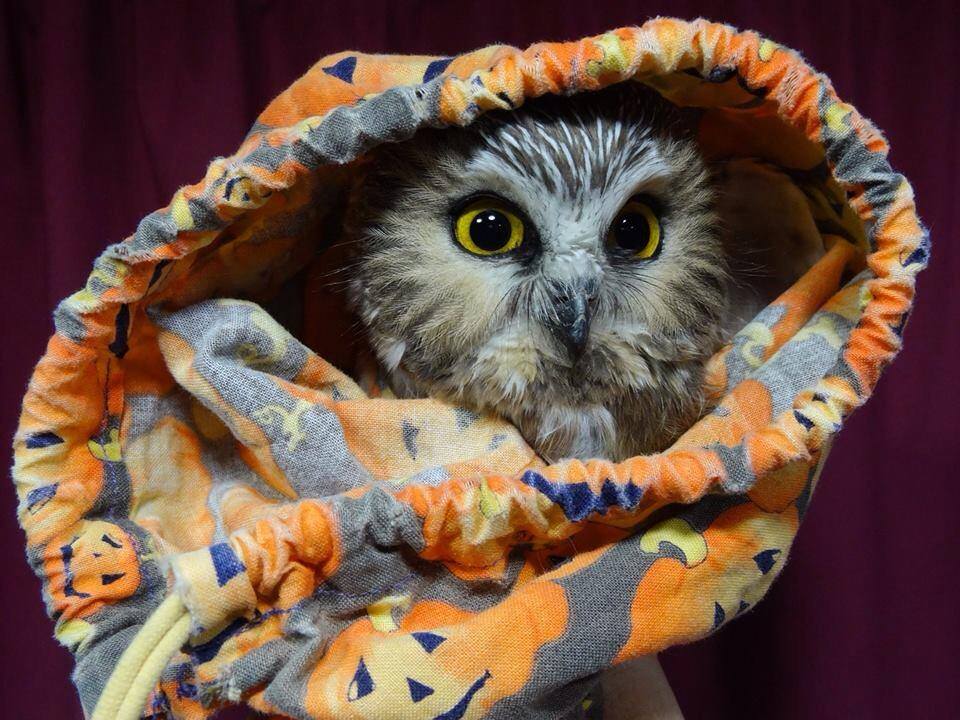 A Northern Saw-whet Owl peeking out of our Halloween-themed bird bag, even though we haven’t quite reached that date yet (Photo by Simon Duval) |
